ULN-8 mkIV
It’s All About the Sound…
A complete, modular, expandable Recording & Mixing Console with 8 boutique mic preamps, world-class converters, a studio full of outboard gear and a professional Atmos capable analog monitor controller.
Integrated with a future-proof computer interface.
Heavenly Metric Halo Sound
mk IV Analog, Preamps & Conversion
For over 20 years, Metric Halo sound has been beloved by musicians and audio engineers the world over.
Our 4th generation mkIV analog and converter stages enhance the already world-class design of the ULN-8 to provide you with warm yet detailed, open & musical sound that captures and presents your work in its best light.
Monitoring
Analog + Atmos + Processing
The mkIV features a full featured multi-source, multi-destination surround capable (up to 7.1.4 Dolby Atmos®) monitor controller with analog gain control and relay hard mutes.
Mixing
128 Channels | 64 Buses | 192k
Imagine having a large-format recording and mixing console in a 1RU unit. mkIV is just that — you will not be limited by this mixer.
MHLink
Network Audio Backplane
MHLink provides an ultra-low-latency, ultra-high-bandwidth self configuring audio and data backplane between multiple MH units as well as a native Gigabit Ethernet interface to the computer.
USB
Driverless Class Audio
Every mkIV unit includes a USB Class Audio interface that allows you to connect to any USB Audio host (Mac, iPhone, iPad, Android, Windows 10+, or Linux) without having to install a driver.
SCP
USB I/O Sidecar
In an MHLink system, the USB port on each mkIV unit provides our unique “Satellite Computer Port (SCP)” capability.
SCP gives you the ability to patch a satellite computer with full routing into the mkIV Mixer. On multiple unit systems, all SCP ports are available simultaneously.
Integrate software instruments, sample players, client computers and mobile devices into your system without the need for additional interfaces or complicated clocking setups.
Loopback
Flexible Re-routing
Any channel in the MIO Mixer can be routed to any output, including outputs sent back to the host or to an SCP port.
Route audio between apps or computers without any additional software or an additional complex routing model.
Signal Processing
FPGA/DSP Hybrid Engine
mkIV features our custom hybrid DSP/FPGA processing system that provides massive amounts of processing and gobs of memory for high-precision fixed point mixing, cross-point interpolation, metering and routing as well as flexible, instantiable floating-point plug-in processing.
Plug-ins
Zero-Latency DSP
mkIV bundles over a 100 zero-latency hardware plug-ins, including the entire Metric Halo Production Bundle, the +DSP Bundle, the Make Believe Bundle and the Sontec MES-432D9D with no additional license fees or complicated licensing tools.
That’s over $3100 worth of world-class plug-ins bundled for use on the LIO-8 mkIV DSP for free!
Control Surface
Mackie | EuCon | iPad | Tablet
mk IV supports a variety of control surfaces giving you tactile remote control over mix, monitor, and recording.
EdgeBus
Expansion I/O HW Plug-ins
Each mkIV unit includes an open EdgeBus Card slot. The EdgeBus Card slot allows you to expand your system with additional I/O without having to add a new interface.
Boot States
Standalone Operation
mk IV allows you to store the full configuration of your multibox MHLink system into non-volatile memory so that the full configuration is automatically restored when the system powers on - without requiring a connection to the computer or MIOConsole.
Format Conversion
Digital and Analog Conversion
Crosspoint routing and all I/O ports simultaneously active enables you to use the mkIV as a flexible format converter. Boot states allow you to program and set the unit for standalone format conversion
Session
Integrated Tracking DAW
mkIV includes complete tracking DAW that supports Live, Take-based and Overdub recording workflows. Always available and completely integrated with the hardware. It launches instantly as part of MIO Console and it doesn't require any licenses or dongles.
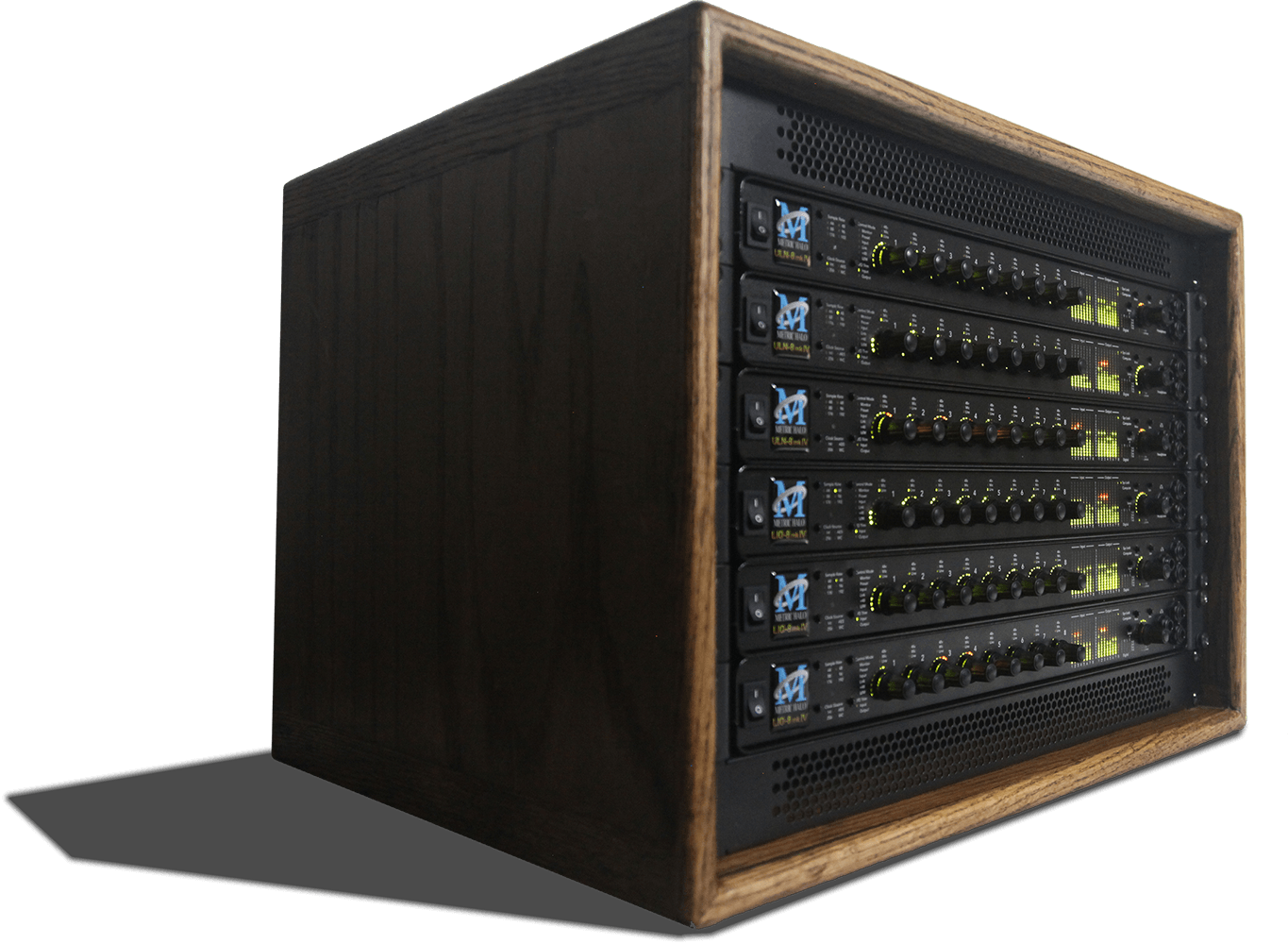
ULN-8 mkIV Key Hardware Features
Whether you are on location, in the studio or the mastering room, the ULN-8 mkIV has what it takes for you to get the job done.
ULN-8 mkIV is built on Metric Halo’s core 3d Technology, so it interoperates seamlessly with all existing MH 3d interfaces.
Since it is amazingly flexible, expandable and future-proof by design, your system always scales to meet your needs. Each unit includes these hardware features:
- Metric Halo’s unique 3d Core Digital Engine with MHLink
- 8 channels A/D with Analog Trim
- 8 channels D/A with Analog Gain
- Stereo Headphone
- Dedicated HP D/A and Analog Gain
- Ultra-low converter latency
- Converter latency reduced by 85% compared with previous generation
- Round-trip through Converters + Mixer + DSP + Monitor:
≈ 0.9ms @ 44.1k
≈ 0.2ms @ 192k
- 8 channels MH ULN-R preamps
- 2 channels Guitar/Bass DI inputs
- 8 channels AES Output
- 8 channels AES Input
- SMPTE LTC I/O
- MIDI I/O
- 128 Channel x 64 bus mixer
- Integrated DSP
- Full support for 192k
- Detailed Front panel metering
- FP control with dedicated gain knobs
- IR Remote Control support
- MH EdgeBus Card slot
- MHLink Gigabit Ethernet connectivity
- USB-C connectivity
- Low power, cool-running design with no fans
The mkIV excels in these key areas:
Integration for the Win
By implementing all the functions of a complete end-to-end signal chain solution in a single package, the ULN-8 mkIV is able to provide unprecedented capability and quality in a lightweight, low-power, single rack space unit. This integration has significant benefits in the form of reduced setup time and greater reliability, reduced cabling, weight, power consumption and cost, even as it provides unprecedented flexibility and performance.
The MHLink routing and transport architecture allows you to build a system with units distributed up to 100 meters apart with no added latency.
MHLink's auto-configuration and hardware aggregation make it so the entire system appears to the host computer as a single unified interface. Audio, command and clock transport with up to 256 channels of audio (at 192k) is accomplished with light-weight, inexpensive, readily available Cat 5e cabling.
The new mkIV design is eco-friendly and uses very little energy to provide its incredible performance and power. Even when every mic channel is powering a 48v phantom mic, the ULN-8 mkIV only consumes 25 watts, and without phantom uses less than 21 watts.
This low-power design allows the mkIV to run cool and stable. No noisy fans required.
Metric Halo Sound
The sound of an audio product is more than the the sum of its parts. You can’t simply look at the components used and determine how something is going to sound. Excellent audio requires careful attention to detail and the tuning of every element of the entire system; this includes the analog stages, the power system, the clock and the converter itself. As all of these interact with each other in nonlinear ways, it is the system that determines the performance, and not any of the individual parts.
The A/D/A converters in the ULN-8 mkIV are DC-coupled to the analog I/O stages so they introduce extremely low phase distortion. The D/A has no low-frequency filtering. The A/D converters have an extremely low frequency DC blocking filter that calibrates the input path and removes DC offset with minimal phase shift.
Every element of the design combines to give you a warm, open 3-dimensional sound that is highly revealing and yet totally natural. Metric Halo mkIV sets a new standard.
It’s digital with soul.
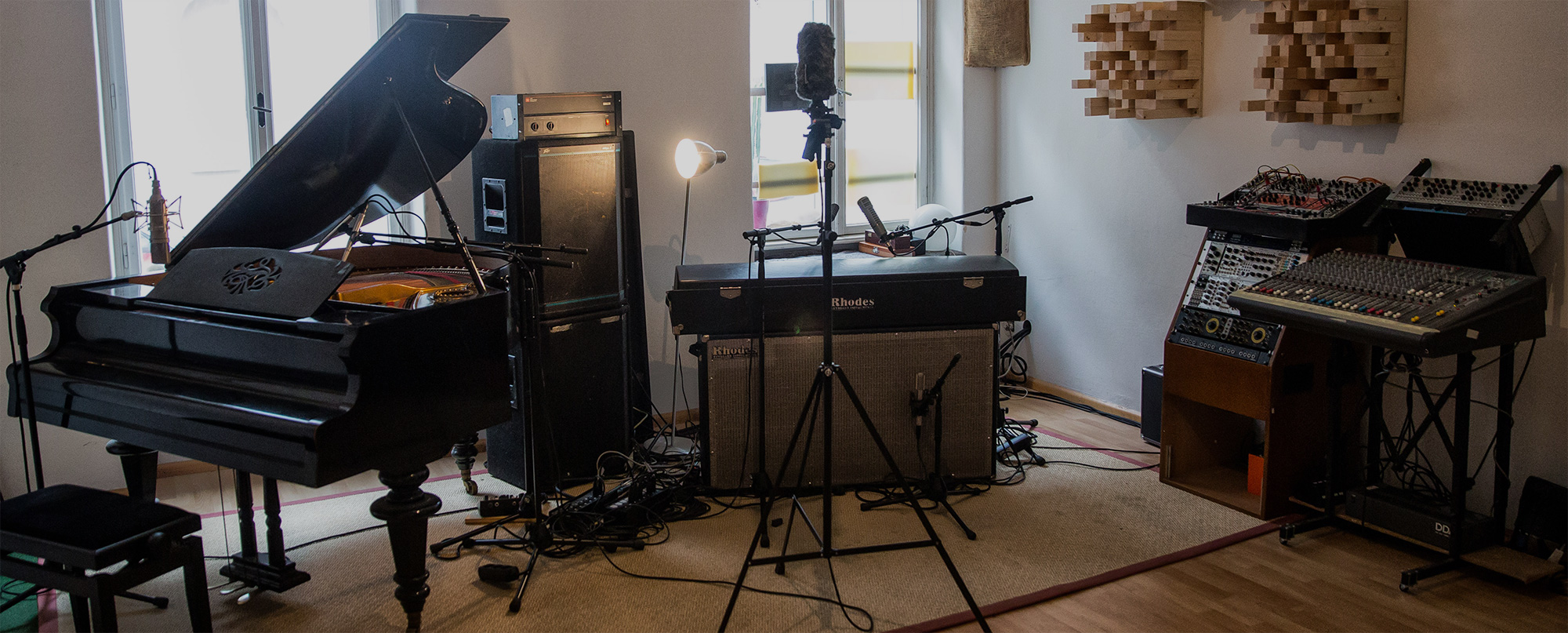
Preamps
The ULN-8 mkIV includes 8 channels of Metric Halo’s renowned ULN-R preamps. These boutique preamps are famous for their pristine, low-distortion, completely unveiled sound.
The ULN-R preamp provides up to 90 dB of digitally-controlled analog gain in precisely recallable 0.5 dB steps. Each input supports independently switchable P48 phantom power.
The combination of the super transparent ULN-R preamp and Metric Halo’s exclusive insertable Character Component Modeling Processing provides flexibility and sound quality that’s unavailable on any other device. You can transition from a wire-with-gain pre to a gooey tube pre or anything in between; every input can have the right Character for the sound you want.
The preamp input path on the ULN-8 mkIV always has preamp gain control and has DC blocking for the phantom power, it also supports input levels of up to +20dBu with no fidelity reducing pads, so you can handle high SPL with sensitive mics as well as you can handle extremely low SPL with insensitive mics (like ribbon mics and low output dynamics) while maintaining ultra-low noise.
The high maximum input level of +20dBu also means that you can use the mic pre input path as an alternative line input path. This feature can be used with the monitor controller to access an additional 8 selectable analog inputs as external sources.
The ULN-8 mkIV input path features an integrated analog send (pre A/D converter) which allows the unit to be used as remote controlled analog preamp. MHLink connectivity and control means that your preamps can be really remote (up to 100m away from your control interface) when you need them to be.
The preamps also offer a send/return mode where the amplified signal from the preamp is sent to the analog send and the line input is used for the return to the A/D converter - this allows you to patch analog processing between the preamp and the converter. Finally, you can use the analog send to provide the pre-amplified signal to a backup recording or mixing system; this is a fully analog split that represents a true backup signal with no digital dependencies.

Monitoring
Monitoring is critical to the production process at every stage; you need to be able hear exactly what you are working on. Your monitor chain will be limited by the weakest link in the chain. The ULN-8 mkIV integrates a transparent digitally controlled analog monitor controller to ensure that you can connect directly to your reproduction chain without having to reduce the fidelity of your signal with an inferior monitor control system.
mkIV hardware includes a relay driven shunt mute circuit on all the analog outputs that prevents transients from getting into your power amps and speakers. The mute is designed to be completely out of the circuit under normal monitoring operations. It automatically protects your monitors during power cycles and sample rate changes.
The Monitor Controller in the ULN-8 mkIV provides sophisticated monitor control features that are only available in dedicated monitor controllers that surprisingly cost more than the ULN-8 mkIV.
These features include:
- Multiple source selection
- Multiple speaker output selection
- Output paths can share speakers
- Per speaker gain and delay
- Per speaker solo/mute control
- Output path calibration support
- Multichannel support from Stereo up to 7.1.4 Surround (Dolby Atmos®)
- Mono fold-down
- Mute and Dim
- Analog gain control
- Talkback
- Listenback
- Multiple cue output support
- PFL/AFL integration with the mixer
In addition to all these high-end features, the MH Monitor Controller provides unique support for per-output-path configurable signal processing including EQ, Bass Management and protective limiting. Each output path can have its own signal processing, even if the paths share speakers. This allows you to configure alternate monitoring setups with one monitoring system (for example, you could configure the signal processing to provide a band-limited monitoring path or a path that lacks subwoofer reinforcement).
Each ULN-8 mkIV includes a high quality headphone amplifier with dedicated D/A conversion (which is the same quality as the primary D/As in the system), and digitally controlled analog gain control. So you don’t need to add a headphone amp to your system. By default the headphones are configured as a parallel Cue output multed from the Monitor Controller, but you can drive the headphones with an independent mix or you can make them an alternate output for the monitor controller.

Cue Control
In addition to monitoring the mix in your control room, multitrack production requires providing multiple output cues to performers, producers and/or broadcast feeds.
The Monitor Control in 3d is enhanced by a sophisticated Output Cue section that provides you with an arbitrary number of output controls. Each cue can be driven from any of the busses in the system, or it can be set to derive its input from the currently selected source in the Monitor Controller (MC).
Since each Cue can be driven by a separate mix bus from the mixer, they are perfect for routing and controlling independent headphone mixes for individual performers.
Cues can be configured to listen to PFL/AFL (or not). So for producers and engineers, the cue can follow PFL/AFL Solo in the mixer while performer and broadcast cues are unaffected by soloing.
Each cue has an independent output path which can be set to any of the MC supported output types. Each cue controller uses the MC engine for its control of routing, gain, delay and output graph processing, so it can do all the things the MC can do.
Cues form the basis of the routing points for Talkback and Listenback.
Talkback provides the ability to route a specific input to any sub-set of the cues in the system; it also allows you to control the amount that the Cue source signal is dimmed when talkback is active. The Talkback signal is mixed with the selected source.
Listenback provides the ability to route the source that the engineer is currently monitoring through the Monitor Controller to any subset of the cues in the system. This allows playing back a mix of the take to any or all of the monitoring cues in the system without having to re-patch.

Ultimate Console and Mixer Solution
For 3d and mkIV, we designed a new, retina-enabled, 64-bit, cross-platform console application: MIO Console 3d.
MIO Console features a high-impact, modern, flat design with scalable UI elements. With user controllable color theming and extensive support for user-configurable interaction preferences, it is easy to tune the console to fit your style (and your eyesight). MIO Console also adds support for standard UI gestures including drag-and-drop for inserts and multi-strip control swiping.
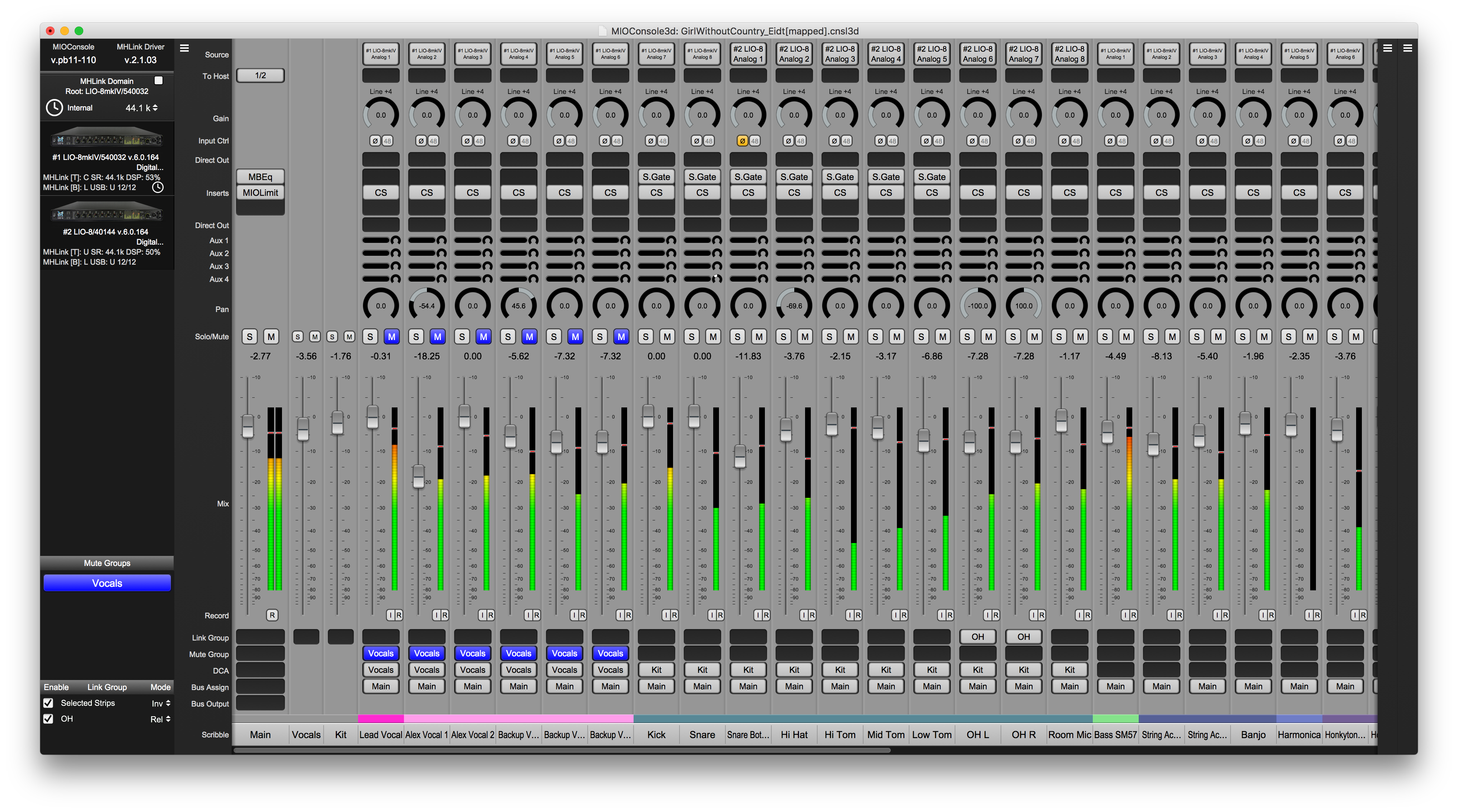
MIO Console provides the UI to control the mkIV Mixer. This mixing engine is a full blown mixing console - not a mere interface monitor mixer. It features multi-bus mixing, arbitrary routing, input and output multing, zero-latency hardware plug-ins, surround support, and headamp control. The Mixer removes the limits that other interfaces have by providing:
- Up to 128 channels of input (@192k)
- Up to 64 (mono) busses (@192k)
- Mix busses that span all the hardware in your MH system
- Mix and panning support from mono up to 7.1
- Automatic routing to the computer
- Cascade assignment of inputs, sends, busses and plug-ins
- Instantiating plug-ins and graphs with presets
- Dragging plug-in inserts within the mixer (including drag-copy)
- Unlimited Parameter Link Groups
- Unlimited DCAs
- Unlimited Mute Groups
- Hardware polarity invert
- On-strip headamp control
- Pre- and post-insert direct outs
- Hardware I/O inserts
- Latency compensated buss-to-buss summing
- Support for automatic input switching and punch-in with Session
- Support for automatic Session I/O routing
- Comprehensive metering
- Optional non-destructive AFL/PFL soloing
- Hard Mutes
- Fully configurable Main, Aux and Group busses (up to a total of 64 mono busses)
- Aux sends directly on mixer strips
- Flipping Auxes onto the primary mix surface (in both the UI and on hardware control surfaces)
These features taken together unlock mixing workflows specifically targeting live and zero-latency cue mixing during tracking as well as enabling you to record and mix with Session as a dedicated solution.
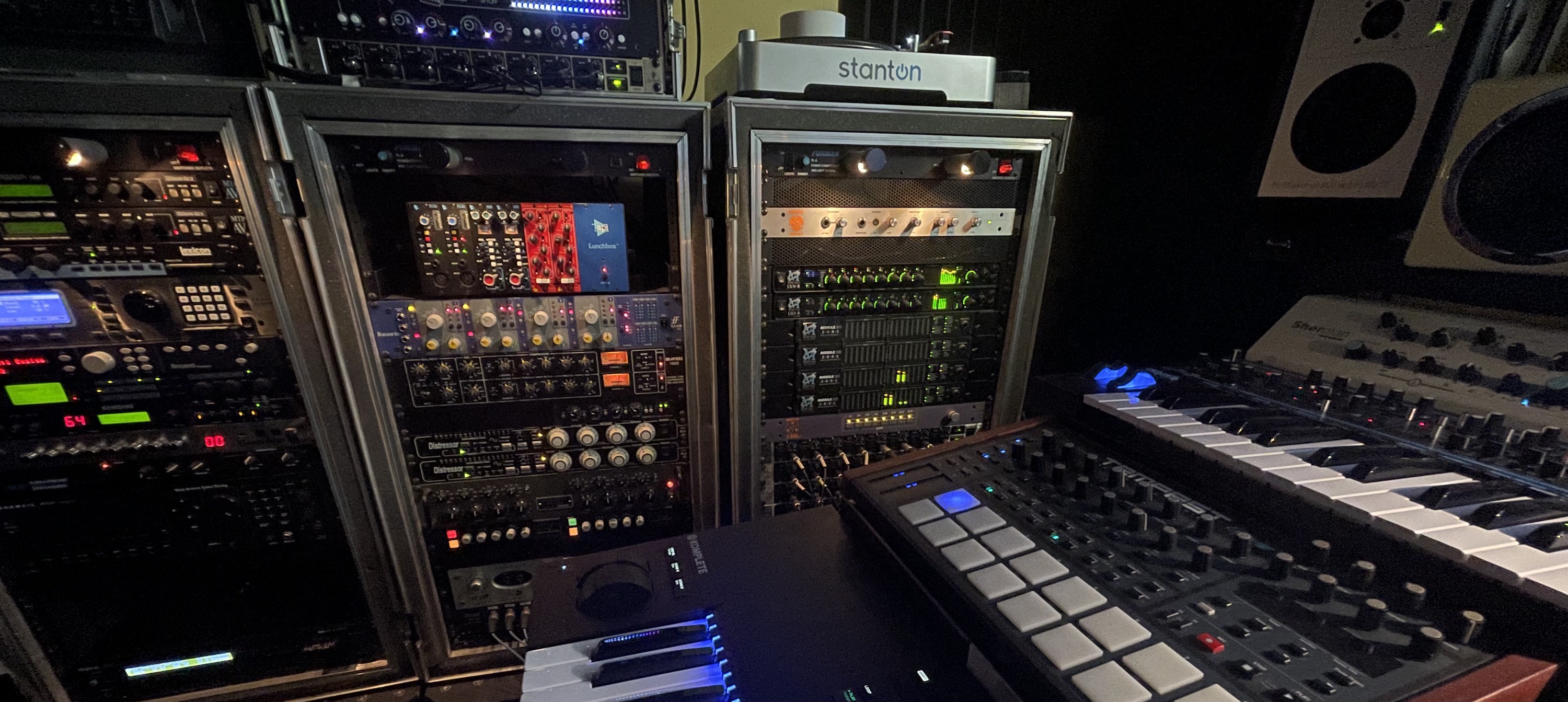
MHLink - All Together Now…
MHLink redefines audio interconnect technology.
It supports up to 128 channels at 32-bit/192k, bidirectionally, on each port.
MHLink intelligently manages low-jitter audio clock distribution, high-bandwidth audio streaming and system control data all on a single lightweight, inexpensive, industry-standard Cat5/5e Ethernet cable.
The MHLink transport automatically unifies all connected devices into one super unit — which maximizes your audio performance while minimizing complexity.
Expanding your system is as simple as chaining another unit.
- Step 1: Plug another unit to the end of the chain.
- Step 2: There is no step 2.
MHLink devices can be added dynamically without interrupting running audio streams. All I/O ports of new devices are automatically available for routing within seconds of being connected.
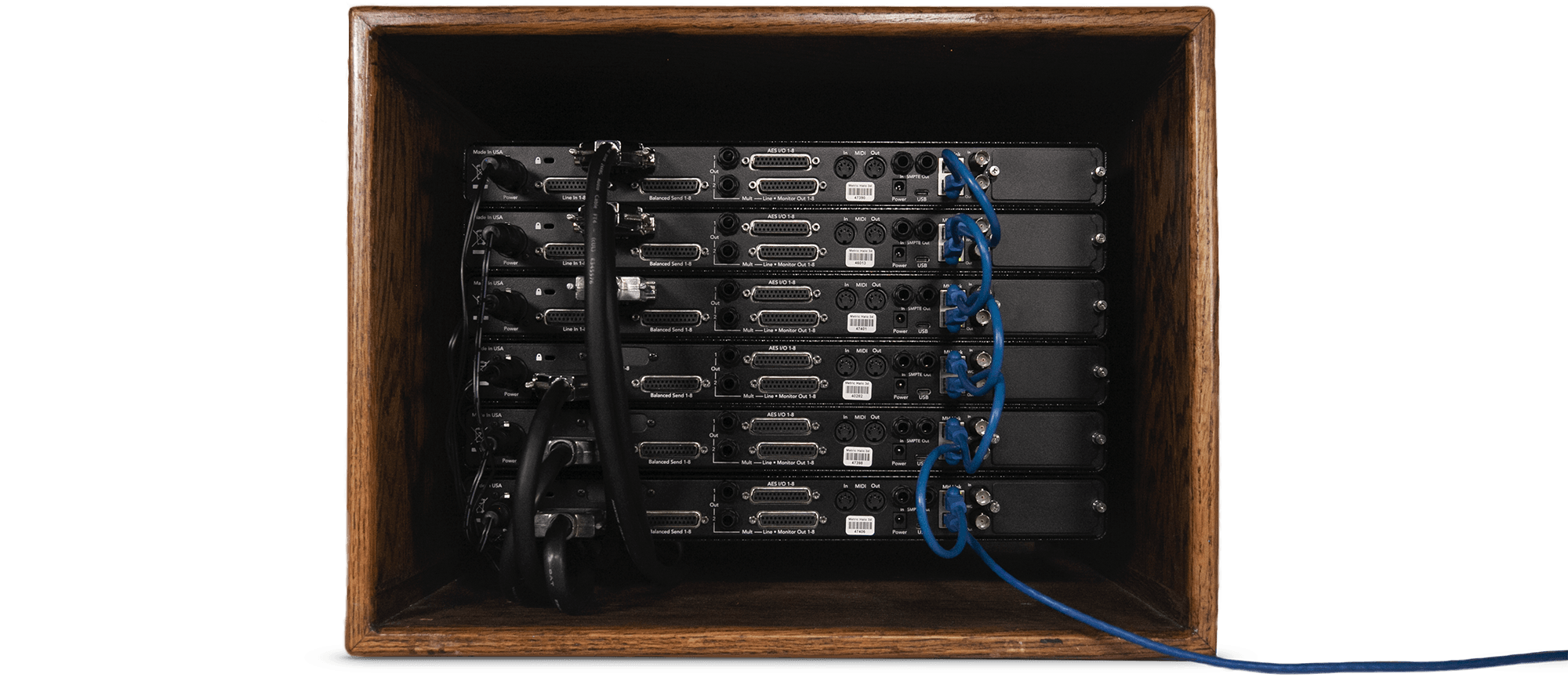
MHLink key features:
- There is no latency offset between the individual devices. With MHLink, the maximum transport latency between units is 16 microseconds, regardless of whether two units are directly connected or there are 16 additional units in between.
- Up to 100 meter MHLink Cables — Say goodbye to your expensive, heavy, noisy analog snakes. Place your Metric Halo setup where it is best positioned and remove hundreds of meters of analog audio cable. Easily connect your Metric Halo unit with commodity Cat5/5e cable with up to 100 meters of cable length per MHLink connection.
- Split systems — With up to 100 meters of cable between units, put your primary system on stage (or your live room) and your monitor box at FOH (or your control room). MHLink adds no latency and provides a common clock; you can even use existing installed wiring plants for tie-lines.
- Integrated daisy-chain support — No need for the added expense and complexity of Ethernet switches.
- MHLink uses true locking connectors to provide security from cables getting snagged and disconnected at the worst possible time.
- MHLink is transformer coupled at each port so all your MHLink connections are galvanically isolated. This makes operation extremely safe while also protecting your recording system against electrical interference and the introduction of data-path ground loops.
- Integrated, Automatic Clocking — No need for word-clock or any other digital interface to transparently lock multiple MH Linked units’ clocks.
- Standards-compliance provides support for both direct connection and switched connection to computers via MHLink.
Instantly Scalable
A unique feature of MHLink is that all Metric Halo interfaces work as well as a group as they do individually. Mix and match ULN-8 mkIV with other 3d units to create a system that meets your needs for track count and preamp power.
Adding a unit to the system automatically increases the DSP power of the system, so that your DSP always scales with your I/O.
Break your system up for small gigs when playing out or add the units of your mates to build a huge system when required - just click to connect!
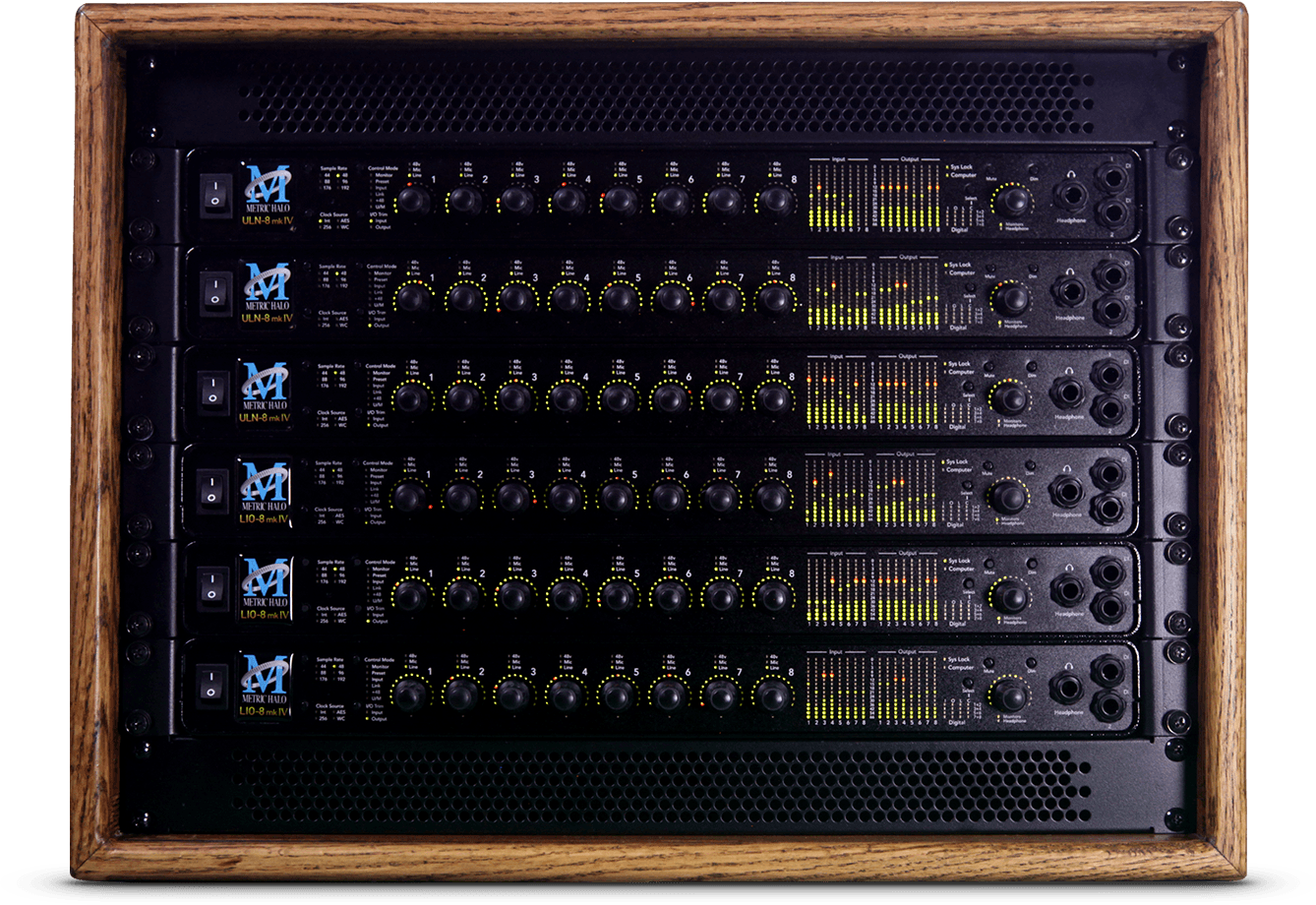
USB
Every mkIV unit includes an industry standard USB-C port that provides a device port featuring 3 interface endpoints:
- USB Audio Class 2
- USB MIDI Class
- MIO Control Class
The Audio Class and MIDI Class endpoints support industry standard protocols and allow the mkIV to be used with the built-in drivers of any USB host that supports the standard classes.
You can transport audio and MIDI to and from computers running macOS, Windows 10 & 11, or Linux without installing a custom driver.
You can transport audio and MIDI to and from mobile devices (and embedded devices) that don't allow the installation of custom drivers, as long as the devices provide built-in Audio and/or MIDI class support. At present iOS devices (including iPhone and iPad), Android devices (phones and tablets) and AKAI MPC have the appropriate class drivers included.
MIOConsole3d also controls the unit over USB so you can connect your computer with one cable.
SCP
Have you ever wanted to connect an iPad to your main studio system? How about dedicating an older computer you have laying around to running a VI or a Sampler? What about when a client or collaborator comes in with their laptop and wants to run audio into your system? With mkIV and SCP, you can just connect any of these devices right into your system without having to add another interface just for that purpose.
mkIV supports explicit routing to and from the USB connector on any unit in the MHLink chain. When used in this way the USB ports are referred to as Satellite Computer Ports.
This feature allows you to integrate audio from multiple USB host devices (computers, phones, tablets, MPCs, etc.) without having to purchase additional interfaces. It automatically keeps your devices synchronized with your system and provides device to device routing as well as integrated mixing and processing.
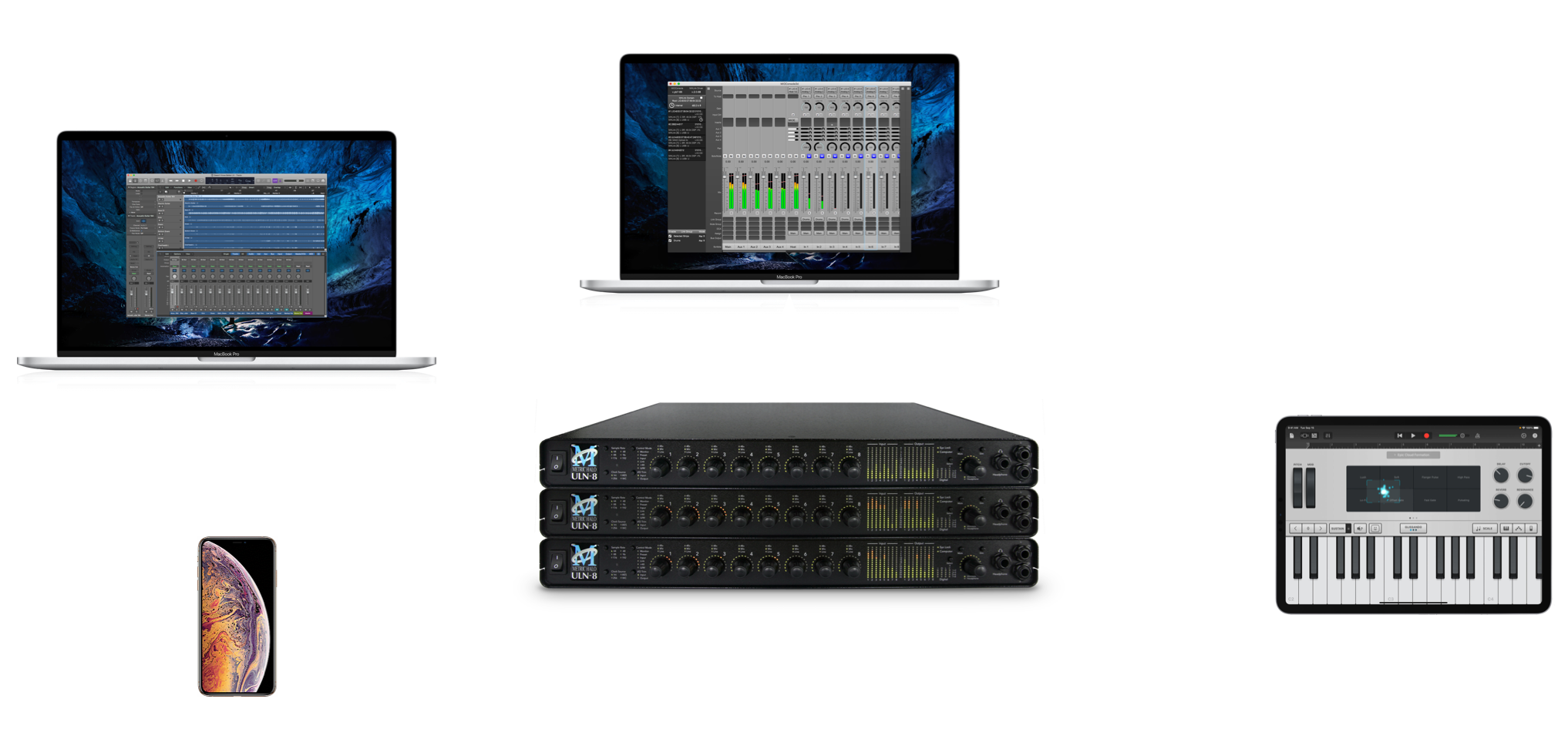
You can connect a sampler running on a another computer and directly mix its outputs with the rest of your sources. You route directly between computers/devices or mult signals to multiple computers/devices - so you can set up a computer or an iPad as an effects rack or backup recorder.
You can integrate the output of multiple iOS instruments into your MHLink Mixer via the direct digital link and you can record real-time performances by routing them to your main recording computer.
You can use the SCP functionality to integrate multiple computers (or iOS devices) into your MHLink mixing engine. Each USB port is available for connection with a USB audio host. The SCP USB source and destination categories in the routing selector popups allow you to select explicit USB channels to route to and from.
To use a USB port as an SCP port, simply connect the device to one of the USB ports on one of the units in your MHLink chain. Then on the device, select the USB interface of the connected 3d unit as the audio interface for the device, signal processing software or DAW.
It’s as simple as that.

Loopback
Have you ever wanted to route audio from one app to another? For example maybe you want to capture a reference track from a streaming service or you need to grab the output of your DAW (post analog processing) and capture it to your mastering app. Or perhaps you need to route some audio from a pro app to your teleconferencing software.
The mkIV mixer supports the computer and SCP ports as first class routing destinations which makes it easy for you to route any signal back to the computer or any of the SCP ports.
You can use this feature to route audio between apps on one computer, between different computers, or to mobile devices.
Since the routing points are built into the mixer, the signals you loop-back to the computer can be outputs from the computer, any mix, or the output of any signal processing chain.
You can use this feature to capture masters, route between your DAW and teleconferencing apps, or between standalone VIs and your DAW.
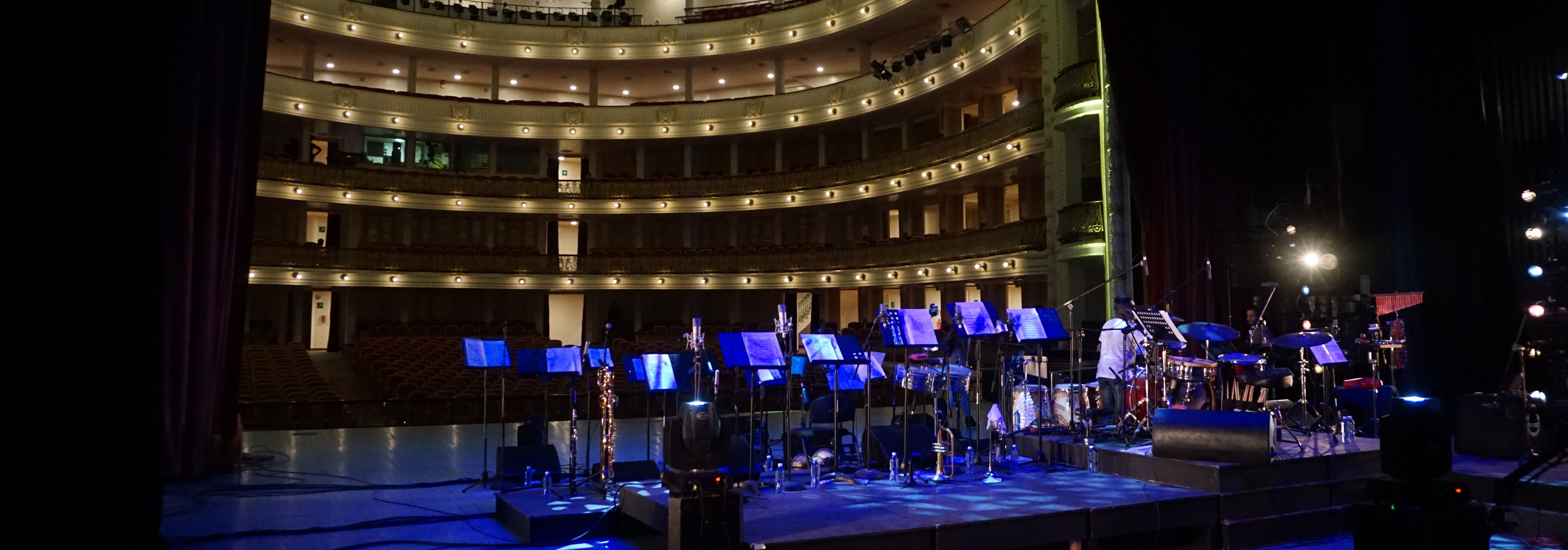
Processing
ULN-8 mkIV includes a sophisticated digital signal processing engine that is only limited by your imagination. The mixing engine and audio router built into each unit is capable of mixing 128 inputs to 64 busses at all sample rates (up to 192k) with every gain interpolated on a sample-by-sample basis. This custom dedicated mix engine utilizes the equivalent DSP power of 30 of the SHARC DSPs that were used in our previous generation product (based on the 2d Card).
Each ULN-8 mkIV also includes a programmable DSP that supports the instantiation of arbitrary DSP processing plug-ins; this is used for insert processing in the mixer and for output processing in the Monitor Controller. ULN-8 mkIV includes over 100 plugins that you can use for low-latency monitoring, live mixing or in production. The DSP in 3d has 1GB of DDR3 RAM available so long delays and multiple reverbs are not a problem.
The +DSP license included with every unit provides Metric Halo’s unique Graph insert which allows you to build your own signal chains with arbitrary phase compensated routing between plugins; think of it as a DSP playground. You can insert a Graph in any insert slot in the mixer and as output processors in the Monitor Controller.
The 3d system enhances the processing engine included in each unit by routing between multiple units and utilizing the resources of all units attached via MHLink as one unified system. Your DSP and mixing resources are pooled. This allows you to seamlessly grow your system one unit at a time - all the way up to 128 channels of simultaneous input and output! All your inputs (including inputs from the computer) are available as sources in the mixer and monitor controller. All your outputs (including returns to the computer) are available as destinations for the mixer, monitor controller, cue system and direct outs.

Plugins
All the plugins below are available for instantiation on the hardware. This allows them to be used with zero latency during tracking, monitoring and live-mixing. It also makes them available for mixing recordings made with Session.
These plugins include the full feature set of the Production Bundle plugins, including things like the embedded SpectraFoo Real-time Spectrum Analyzer. The 3d versions of the Production Bundle plugins share user presets with the Native Production Bundle plugins, so presets saved with the MH Preset system are usable in all versions of the plugins for easy migration to native DAWs.
ChannelStrip
What do Super Mixers Jack Joseph Puig, Serban Ghenea, Billy Decker, Richard Furch and countless others choose as the indispensable channel strip processor for their mixes?
Metric Halo’s ChannelStrip of course!
“I like Metric Halo, I would die if they took that away. I’m a huge proponent of Metric Halo.
Any particular plug-in of theirs?
I like ChannelStrip. Without that, I’d actually be suicidal. Nothing does what that does.”
“I’d attempt to compare it to other similar plug-ins, but the truth is I only use ChannelStrip. To me, ChannelStrip together with Pro Tools is the console.”
“I once found myself in a situation without ChannelStrip, and I tried to mix anyway. It didn’t work. The mix sounded terrible, and I won’t ever try it again. ChannelStrip is absolutely indispensable to everything I do.”
“… I used to do that when I mixed on SSL consoles, but no other plug-in – not even SSL emulators – could replicate that trick quite this way and keep the gain exactly steady. ChannelStrip does.”
ChannelStrip is like having the channel strip section of a large format console - with a few awesome Metric Halo twists.
ChannelStrip integrates everything you need to process the channels that make up a mix as well as process the entire mix bus.
Featuring an Expander, Compressor, multi-band EQ, and a limiter, ChannelStrip provides a unified interface for processing your tracks. It also includes phase invert, channel delay, comprehensive metering and SpectraFoo™ spectrum analysis - so you can see your audio as well as you can hear it.
ChannelStrip is an essential tool for every project. And it is included with every mkIV.
Dirty Delay
MH Dirty Delay is a fantastic-sounding feedback delay processor with integrated Character and Filters in the delay path. Use it to create awesome vintage echo and tape-delay style sounds as well as create lush and subtle spaces in a mix.
Not just a musical feedback delay, MH Dirty Delay is something special. With integrated Filters and Character in the feedback path, you can make it clean or dirty, vintage or futuristic, subtle or nasty.
With dual delay lines, crossfeed, feedback and distortion control, Dirty Delay is capable of creating extraordinarily rich and complex textures and patterns from your audio. Dirty Delay adds texture and movement without the veiling and darkening of the sound that is often associated with feedback delays.
Dirty Delay is equally at home in production and performance.
Character
Character is a plug-in that lets you add the luscious distortion characteristics of classic analog circuits to your source tracks. To create Character we asked top flight tracking, mixing and mastering engineers to send us their favorite analog hardware; the mic pres, DIs and EQs that they used for recording, mixing and mastering. We then used SpectraFoo to measure the ways that these processors add lovely, shiny analog distortion to the sound run through them and modeled this distortion using our proprietary +DSP technology.
Character provides over 20 different models, incorporating the sound of tubes, transformers and solid state devices. Character has a Drive control (and autodrive) to allow you to push the distortion even harder for over-the-top sound mangling.
TransientControl
TransientControl is a plug-in that allows you to modify dynamics in ways that just aren’t possible with traditional compressors. You can directly change the transient (“attack”) and sustain of your audio; this allows you to make your tracks more punchy, or smooth them out so they sit in a mix.
TransientControl analyzes your audio and distinguishes between the onset of sounds (the attack), the sustain of sounds and the decay of sounds (the release). With three gain controls you can dial in the relative level of these three elements of the sound.
TransientControl can enhance the attacks of finger-picked guitar, or mute the attack of strumming. Use it to make an instrument sit in the mix or pop out. Control the snap of a snare without affecting the ring. Even use it to change the feel of a percussion pattern.
TransientControl does its magic in real-time with no latency, so you can use it for mixing and live.
Precision DeEsser
Precision DeEsser is a plug-in that allows you to manipulate your tracks and remove excessive high frequency content. It combines the high precision filter technology and dynamics processing of ChannelStrip with the metering and analysis of SpectraFoo to allow you to zero in on offending frequencies and correct them quickly and efficiently.
Precision DeEsser features comprehensive listening controls to allow you to hear exactly what is (or isn't) being removed. You can choose five different points in the processing chain to monitor.
The Precision DeEsser is an essential tool for vocal tracks, but can also be used for sound design and other audio processing.
Multiband Expander
MultibandExpander is a plug-in that allows you to manage, suppress and control noise in your tracks in a frequency-sensitive way. The 3-band phase-coherent crossover network directs the audio to three independent expanders that you configure to smoothly suppress noise below the threshold you specify. The expanders can also be configured to change the feel of rhythmic patterns by suppressing elements that are played more softly – all in a frequency-sensitive way.
Multiband Expander features SpectraFoo™ spectral analysis to allow you to zero-in on crossover points and thresholds quickly and precisely.
The Multiband feature of the expander is extremely useful for controlling noise and hum in guitar tracks.
Multiband Dynamics
MultibandDynamics is a plug-in that allows you to add clarity, warmth and punch to your mix. It shapes timbral quality of your audio by running it through a three-band crossover, and providing independent compression in each frequency range before summing the result through a limiter. Without compression, you can broadly shape the timbre of your tracks, and if you need dynamic range control or dynamic EQ, simply enable the compressor for the band.
Multiband Dynamics is an essential tool for mixing and mastering, but can also be used for sound design and other audio processing.
HaloVerb
HaloVerb is a plug-in that allows you to add ambience and depth to your recordings. HaloVerb for 3d expands on the original 2d-Expanded Hardware reverb to give you great algorithmic sound with more flexibility and control. Use the reverb impulse to see the reverberant field as you make adjustments, or hide the graphics and let your ears be your guide.
Add subtle ambience or generate the sound of a vintage echo chamber - the extensive presets and easy to use UI let you dial in the sound you want quickly.
Thump
Thump is a unique audio processor that allows you to synthesize low frequency audio to add low end to a track or generate another sound entirely. Thump looks at the pitch and dynamics of its audio input and uses this information to control its oscillators. You can add low end to drums, augment a bass or even create synthetic drones.
Thump is ideal for beefing up a kick drum, add low end to percussive tracks, re-create classic drum synth sounds, and more.
You can use Thump's envelope driven, percussive sub-harmonic synth for the following things (among others):
- Build low-octave support for bass drum, tom, snare, and other percussive tracks
- Create kettle drum sounds from regular drum tracks
- Re-create the sounds of classic drum synths like the TR-808
SuperGate
SuperGate is dynamics processor that specializes in isolating (or removing) instruments or audio events based on the program dynamic signature. It uses a dynamically controlled state machine to apply precision time-domain gain curves to the processed signal in order to gate or duck material that you don't want.
It features comprehensive controls including hysteresis and hold to allow you to precisely control when the gate opens and closes. It also features an optional, adjustable look-ahead so that you can ensure that initial transients are not cut off.
The UI provides detailed visualizations of the detector and gain signals so that you can see what's happening; which helps with tuning the gate.
The detector can be driven by the signal being processed or by a key-input fed by a bus or input channel. The detector includes an integrated detector sidechain EQ so you can tune the open and close trigger to a specific frequency band.
SuperGate has two processing modes: Gate and Duck. In Gate mode, the gain is reduced when the detector is below threshold. In Duck mode, the gain is reduced when the detector is above threshold. These modes combined with the Attack and Release curve models and the detector sidechain give you unprecedented precision and flexibility in gating and ducking operations. In fact, SuperGate is so tunable you can actually use it as fantastic transient shaper.
Often it is important to be able to hear what the SuperGate is removing rather than what it is passing through, so SuperGate also provides three listening modes so you can listen to the processed material, the detector source material or the source material that is being taken out of the processed signal.
Sonic EQ

Sonic EQ 3d is an extremely flexible EQ with a long history. It's not just another EQ - it's special. Featuring six independent minimum-phase filter bands, each band offers your choice of 8 filter types and 5 function-specific equalization topologies.
This EQ traces its lineage directly back to the orignal process designed by Dr. James A. Moorer for Lucasfilm’s SoundDroid project that evolved into the Sonic Solutions Mastering Workstation. Metric Halo adapted the original design for the native Sonic EQ and for the DSP based Sonic EQ for Sonic Model 30x hardware.
This version now optimized for 3d DSP and adds integrated SpectraFoo spectrum analysis in the UI.
Processing functions include:
- Original Sonic Solutions filter coefficients and filter structure
- Per-band adjustable filter slope order
- Passband Ripple and Stopband Ripple resonant filter controls (2nd through 4th order)
- Updated and improved SpectraFoo spectrum analysis
In every generation of Sonic EQ, two primary characteristics have remained consistent:
Its Sound - It has a full, sweet yet powerful musicality which brings a presence and clarity to literally anything you pass through it.
Its versatility - Whether your need is forensic restoration, sound design, high-end mastering, post-production, recording, re-recording, multi-tracking or live sound, the power and simplicity of this EQ package will get you the sound you are looking for faster and sounding better than you may be willing to believe.
You will find you can make EQ curves with Sonic EQ 3d that look completely broken, yet still sound perfectly clean and natural.
It is no understatement to say the Sonic EQ has been and still is one of the most highly respected and coveted digital equalizer packages on the planet.
Originally bundled exclusively with the Sonic Studio branded Model 302, 303 and 304 Firewire audio interfaces, it has been reborn in 3d with a cleaner and more responsive UI layout, SpectraFoo spectral and level metering and the higher order of musicality, precision and power inherent to the 3d DSP environment.

 In collaboration with Sontec & Make Believe Studios
In collaboration with Sontec & Make Believe Studios
The classic Mastering EQ - fully and accurately emulated.
Nearly 50 years after Sontec introduced the worlds first parametric equalizer, we are proud to bring to life the Sontec MES-432D9D. A faithful recreation of Sontec’s flagship mastering equalizer found in some of the worlds most demanding studios.
Originally designed by Burgess Macneal and George Massenburg the MES has grown to near mythical status. If you are unfamiliar with the MES-432, this article adds a little flavor : ITI AUDIO MES-432C/9
Sontec MES-432D9D
Metric Halo is proud to have spent the past year developing this wonderful equalizer with Make Believe and Burgess and his team.
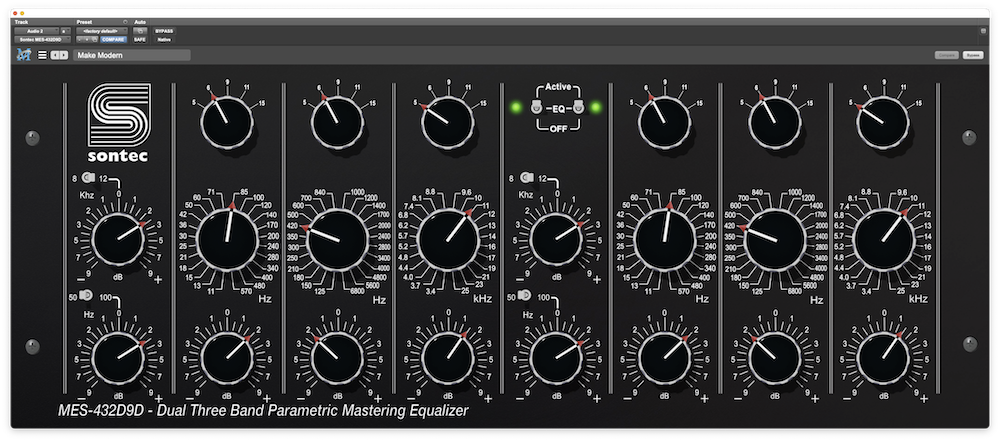
This processor represents new tech (MH State Space Model Extraction) we developed to faithfully capture the curves and character of the Burgess Macneal “blessed” MES-432D9 we used as the prototype for the modeling process.
While the MES-432 is an extremely pristine parametric equalizer, the analog characteristic of the EQ is complex and not directly representable with a standard digital EQ implementation. The MES-432D9D captures these the complex analog shape of the filters and the interactions between the controls, even when running at 1x sample rates.
The extracted State Space Model reproduces the eq correctly, even for the HF bells when running at 1x sample rates (for example, it generates the correct in-band shape, even when the center frequency is at or above nyquist), without oversampling.
 In collaboration with Make Believe Studios
In collaboration with Make Believe Studios
Make Believe Studios is the brain-child of Grammy nominated Mixing and Mastering Engineer Rick Carson.
Rick set out to gather a comprehensive set of classic and rare analog processors coupled with an SSL console and Pro Tools to build a fantastic mixing environment in Omaha, Nebraska.
As a mix engineer, Rick found Metric Halo’s ChannelStrip to be a critical component of his mixing process, and so, when Rick decided to pursue building some new tools based on his experience, he reached out to Metric Halo to help him convert his ideas into reality.
When we heard what he wanted to do, we said “Let’s get going!”
All Make Belive Studios plugins from this collaboration are included with every mkIV unit as zero-latency modelled plugins running directly on the hardware.
MB MixHead
MixHead is a classic 90's style tape emulation. Rather than trying to be an absolutely faithful simulation of analog tape, it captures some of the key elements of the excitement that tape brings to the recording process without many of its downsides.
It is also a key component of Serban Ghenea’s stereo master bus. In fact, Serban graciously contributed a preset that provides the settings that he most often used with the original device. That preset is included with MixHead.
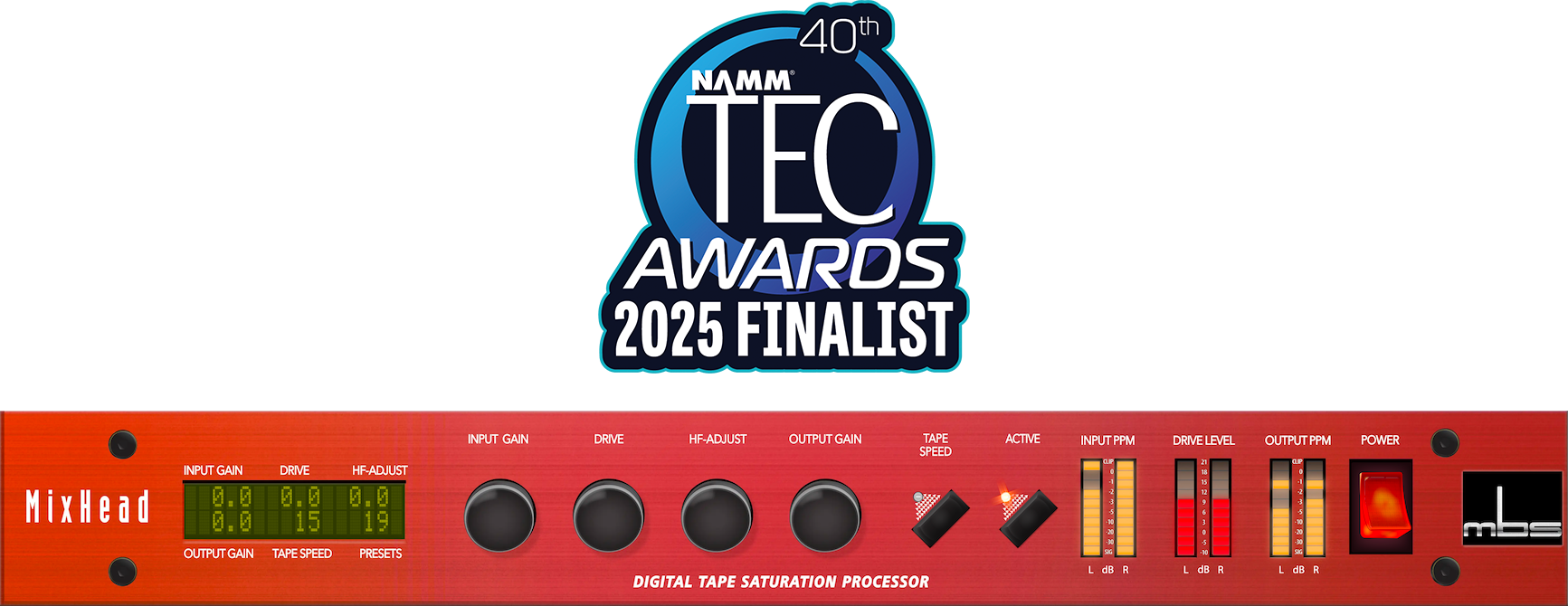
Now, MixHead is a TEC Award 2025 Finalist.
MBSI
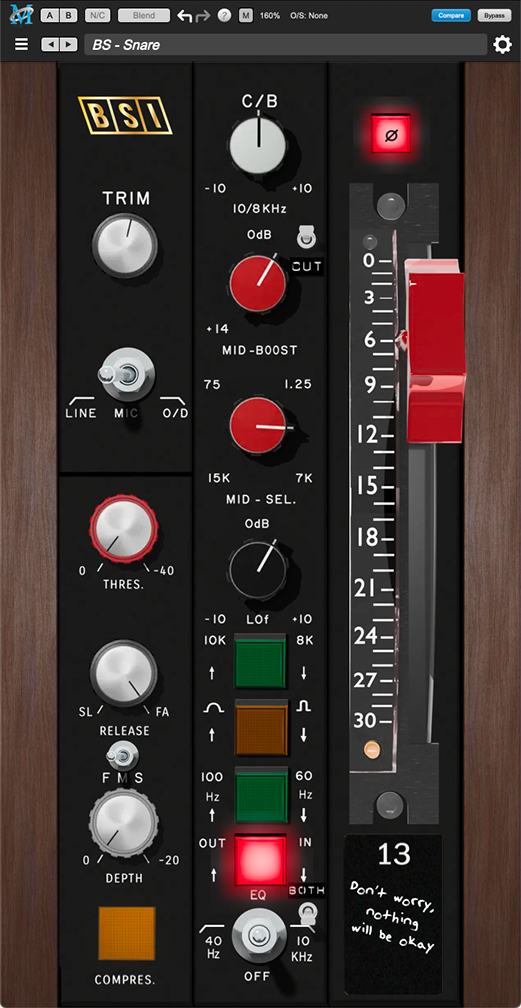 MBSI is a loving and faithful recreation
of one of the most successful custom built consoles in the United States.
MBSI is a loving and faithful recreation
of one of the most successful custom built consoles in the United States.
Custom built by the technicians at MCI for studio C at Criteria Studios, Miami FL, this console was used in the production of dozens of hit records that sold millions of copies.
Artists such as Eagles, Eric Clapton, the Bee Gees, and Grand Funk Railroad chose this room and this Console to work with some of the world's best producers including Tom Dowd and the legendary Bill Szymczyk.
We teamed up with Make Believe and Bill Szymczyk to bring this historic console to you for the first time.
You can learn more about MBSI here.
Now, MBSI is available inside your MIO!
MB Philly DI
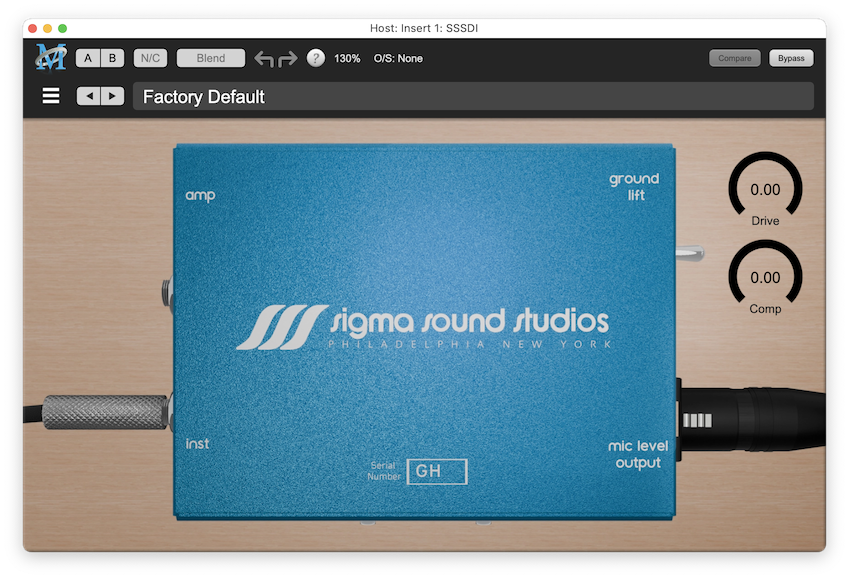
The MB Philly DI is a lovingly crafted digital emulation of the dynamic characteristics and behavior of a pristine infamous DI provided by George Hajioannou of Studio Logic Sound - with a couple of twists:
- The transformer in the DI is so pristine that it actually requires quite a bit of drive to engage the transformer saturation. So we added a volume compensated drive control to allow you to put the signal into the sweet spot of the transformer.
- Since the DI was almost always used with a leveling amp, we added a wonderful one knob compressor; simply turn the Comp knob to engage the compressor - it is gain compensated and has a fixed attack and release.
Use the MB Philly DI to recreate that classic Philadelphia Sound on bass, guitar, keyboards and all sorts of other sources.
MBEQ
MBEQ is an EQ that has been tuned to reflect Rick’s workflow. The user interface is designed to allow you to focus on a quick workflow and sound shaping, rather than a more analytical approach with numbers and knobs.
We also added what Rick calls the “Sauce”: an analog modelled topology based on the incredibly rare classic PYE TVT console modules created for the BBC in the 1960's. This Sauce module includes “Soul-Stolen” transformers and discrete amplifiers - it’s got a lot of character!
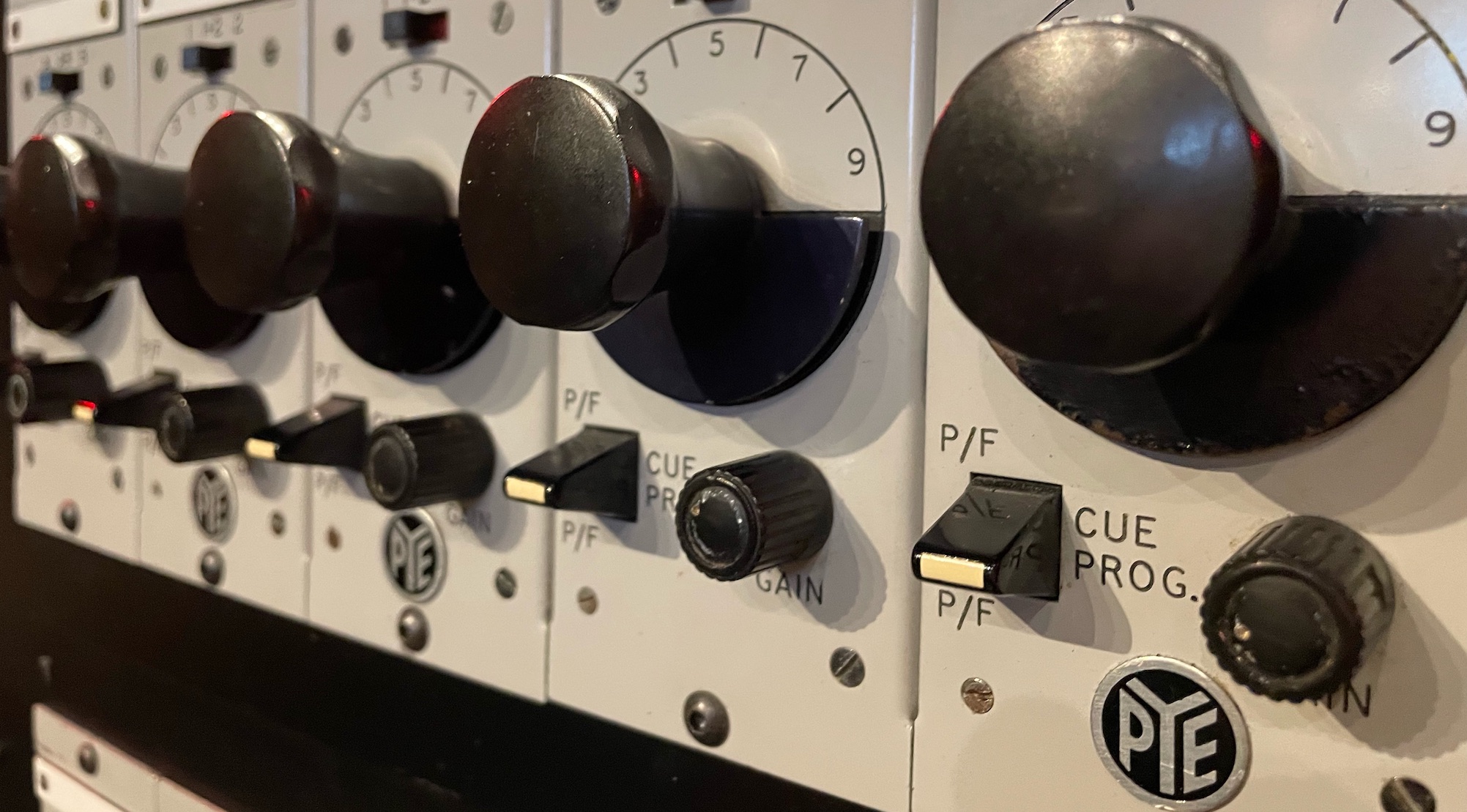
The output level impacts the euphonic distortion created by the analog design, so we added a pre-EQ drive control to allow you to tune precisely how hard you hit the output stage. There is also a post-output stage fader to allow you to fine tune the final output level. Since you can switch off the Sauce, the MBEQ is really two completely different sounding equalizers.
The UI focuses on the EQ itself to allow you to intuitively concentrate on the sound. It features a set of modifier keys that allow you to “play” the EQ like an instrument; with a little practice you can develop your chops and you can effortlessly dial in the tone you are looking for.
The EQ is preconfigured with 7 fully parametric bands and features the ability to add more… up to 12 bands.
Powerful. Intuitive. Sounds Unbelievably good. MBEQ.
MB Parallel 1, 2, & 3+4
“Have you ever wondered how they got that sound? Have you ever searched through old GearSpace postings at 3 in the morning hoping for some nugget of information to take your work to the next level only to find yourself further away from the goal than when you started?
The parallel process plugins are not going to help you sleep better at night, but they may help you get one step closer to a sound in your head!
Crafted after some of the best sounding tricks that I have personally come across, the parallel process plugins take complicated multi-step setup and breaks them down into very simple to use tools.
While they have some suggestions for intended use, we also suggest mixing and matching. You never know what sounds good until you try.
People have been loving a combination of Parallel 1 and Parallel 3-4 in series on a lead vocal; or try using Parallel 2 on a whole mix. None of those tools were designed for these positions but they sound great because they are tried and true tricks from the history of sound!
Parallel 1 is based on a west coast trick for incredibly thick snare drums. It has been found to lend warmth to almost any source you throw at it!
Parallel 2 Smacks. This tool will bring you a step closer to popping right out of a speaker and while originally designed for live drums it has made its way onto vocals and even masters!
Parallel 3-4 is classy top end. This will help anything with midrange sound like it went to a nicer college!!”
MB Good Math
“Good Math is just that. Good Math. If you want to try and get more technical with it you could try and say that it is something between a clipper, a limiter and rounding error but really… It’s just Good Math!”
Kevin's Limiter
A fixed function limiter with no controls, but plenty of style.
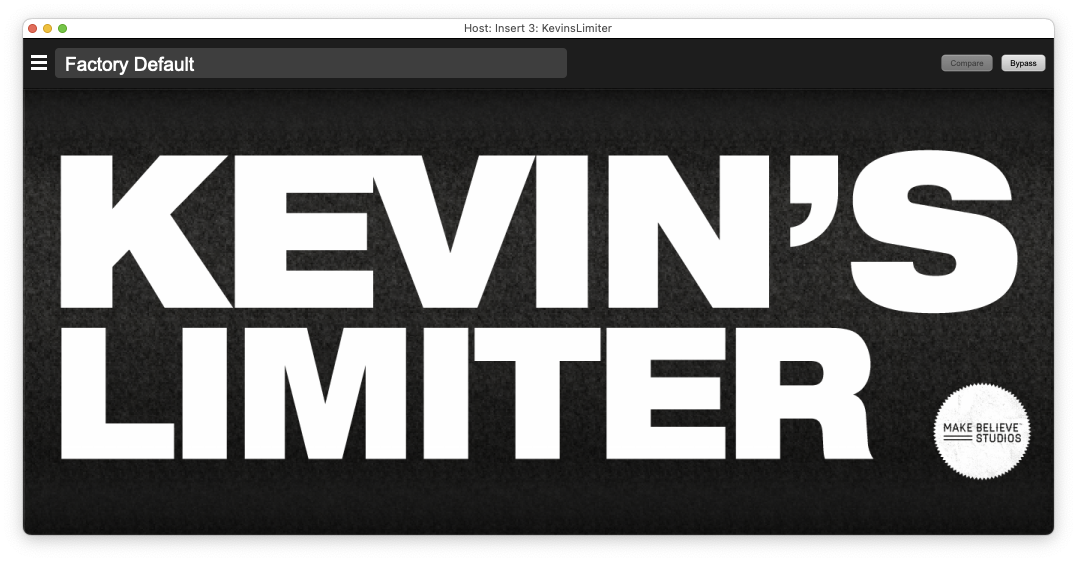
SPRES
An awesome, zero-latency guitar cabinet emulator with two blendable IRs + custom tuning and nonlinearities
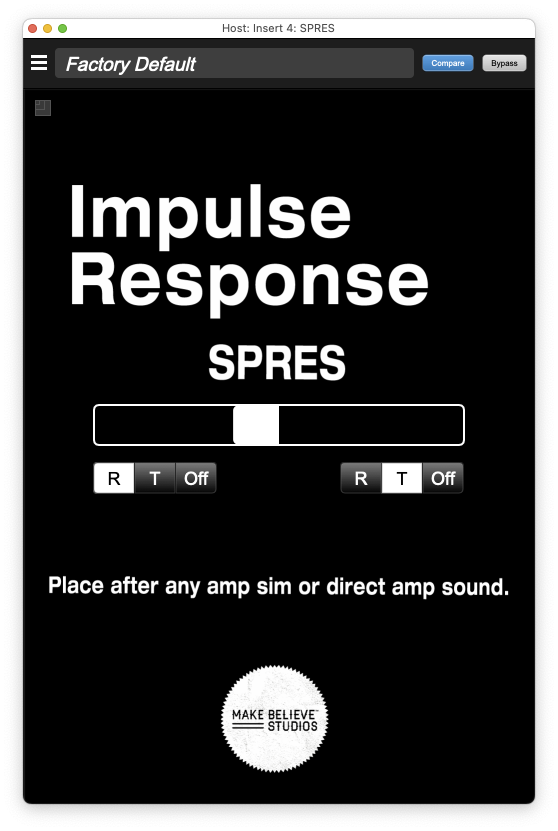
Control Surface
MIO Console supports the industry-standard Mackie Control protocol as well as Avid’s EuCon control surface protocol. If you want tactile control over MIO Console, all you have to do is add one of the many supported control surfaces.
Faders, pans, mute, solo, headamp controls and Session transport controls are at your finger tips, and MIO Console is ultra-responsive - no lag between the surface and the DSP.
You can navigate through your mix from your surface. Moving an Aux to the faders is a single button push, and if your surface has a master fader, the selected bus master is always on the master fader.
The Monitor Controller is also fully supported on EuCon. EuCon support includes things like source and destination selection, gain, mute, dim, mono and speaker mutes. EuCon also supports gain, dim and mute control for Cues.
Control surfaces that support the Mackie Control master section also give you access to tactile control for the Monitor Controller.
The comprehensive EuCon support included with MIO Console means that you can use the free Avid Control app on iOS or Android to wirelessly control your mkIV mixer, headamps and monitor controller.
MH EdgeBus Cards: The Ultimate Plugins
Every 3d-based unit includes an MH EdgeBus Card slot to provide additional flexibility in configuration. The EdgeBus is a programmable high-speed plugin slot that accepts a variety of audio interfacing cards. Its programmable design and full access to all the audio clocks and power rails allows for the creation of a wide variety of digital, analog, processing and interfacing plugin modules.
The currently available modules include (with I/O channel counts listed):
- AES/SPDIF EdgeCard (4 in/4 out)
- DB-25 AES EdgeCard (8 in/8 out)
- SPDIF + MIDI EdgeCard (2 in/2 out + MIDI I/O)
- SPDIF + 2x ADAT EdgeCard (18 in/18 out)
- 2x SPDIF + 2x ADAT EdgeCard (20 in/20 out)
- 4x ADAT EdgeCard (32 in/32 out)
- 2x MADI Optical EdgeCard (128 in/128 out)
- 1x MADI Optical + 1x MADI Copper EdgeCard (128 in/128 out)
- 4x MADI Copper EdgeCard (256 in/256 out)
The EdgeCard modules are field installable/swappable and the hardware automatically detects the type of the installed card. All EdgeCard audio channels are first class I/O and may be used just like the built-in channels; all I/O is available simultaneously.
You can use EdgeCards to interface with other systems, get additional I/O via third-party A/D/A converters, provide ingest paths for digital recorders, or to patch into your existing digital console (e.g. via MADI interfacing).
The high-channel counts achievable via MADI interfacing means that you can us your ULN-8 mkIVs as remote-controlled headamps, side car processing, or as a multitrack recorder for your console.
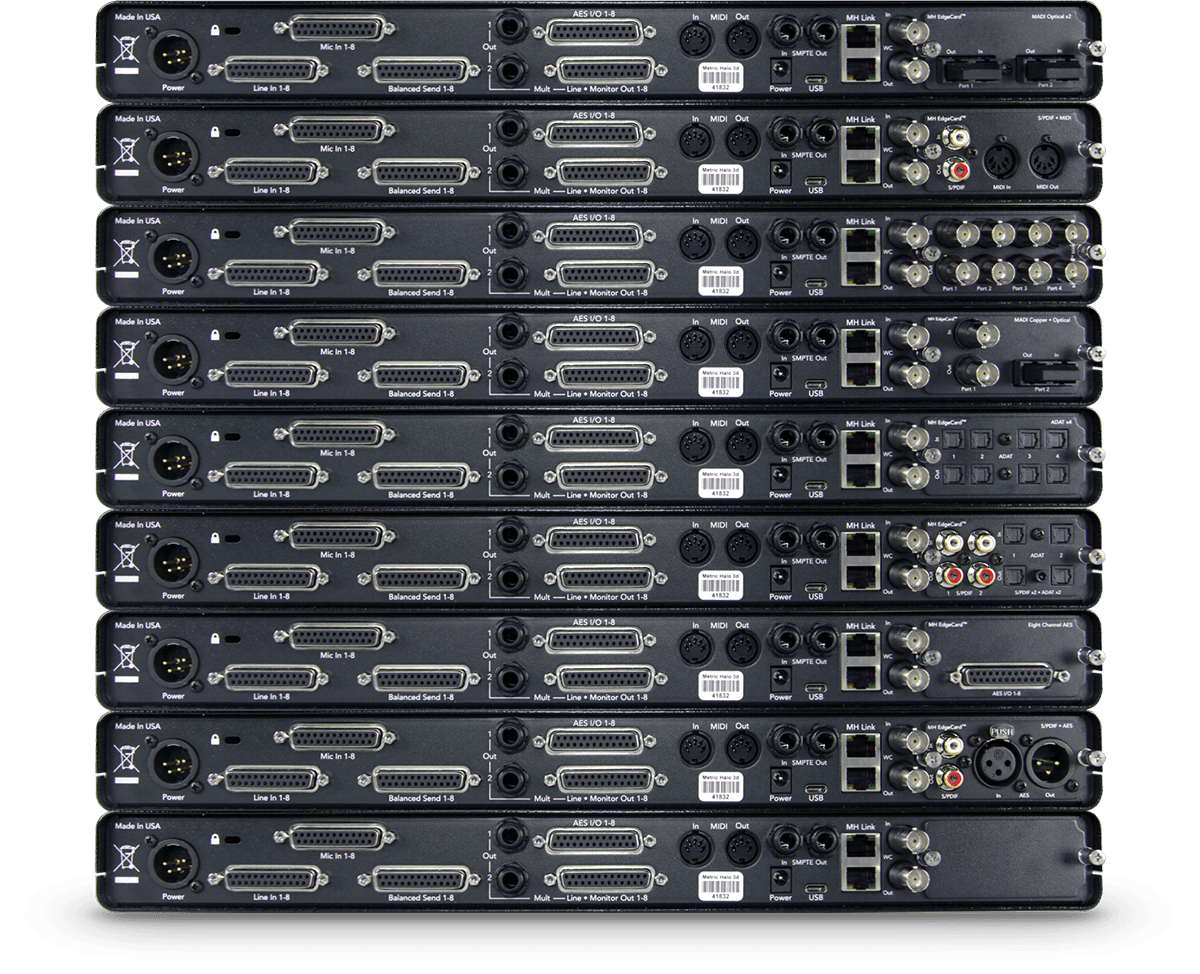
Format Conversion as a First-class Feature
The combination of MH EdgeBus Cards and MHLink provides built-in, low-latency format conversion between multiple digital audio formats. Within one box, you can convert from any of the input formats supported by the box and it's installed EdgeCard to any of the output formats supported by the box and card.
If you need to convert between formats supported by multiple EdgeCards you can simply MHLink two boxes with different EdgeCards to achieve the conversion.
So things like Analog ⇆ MADI, or MADI ⇆ AES, or AES ⇆ ADAT can all be accomplished without any third-party converter devices.
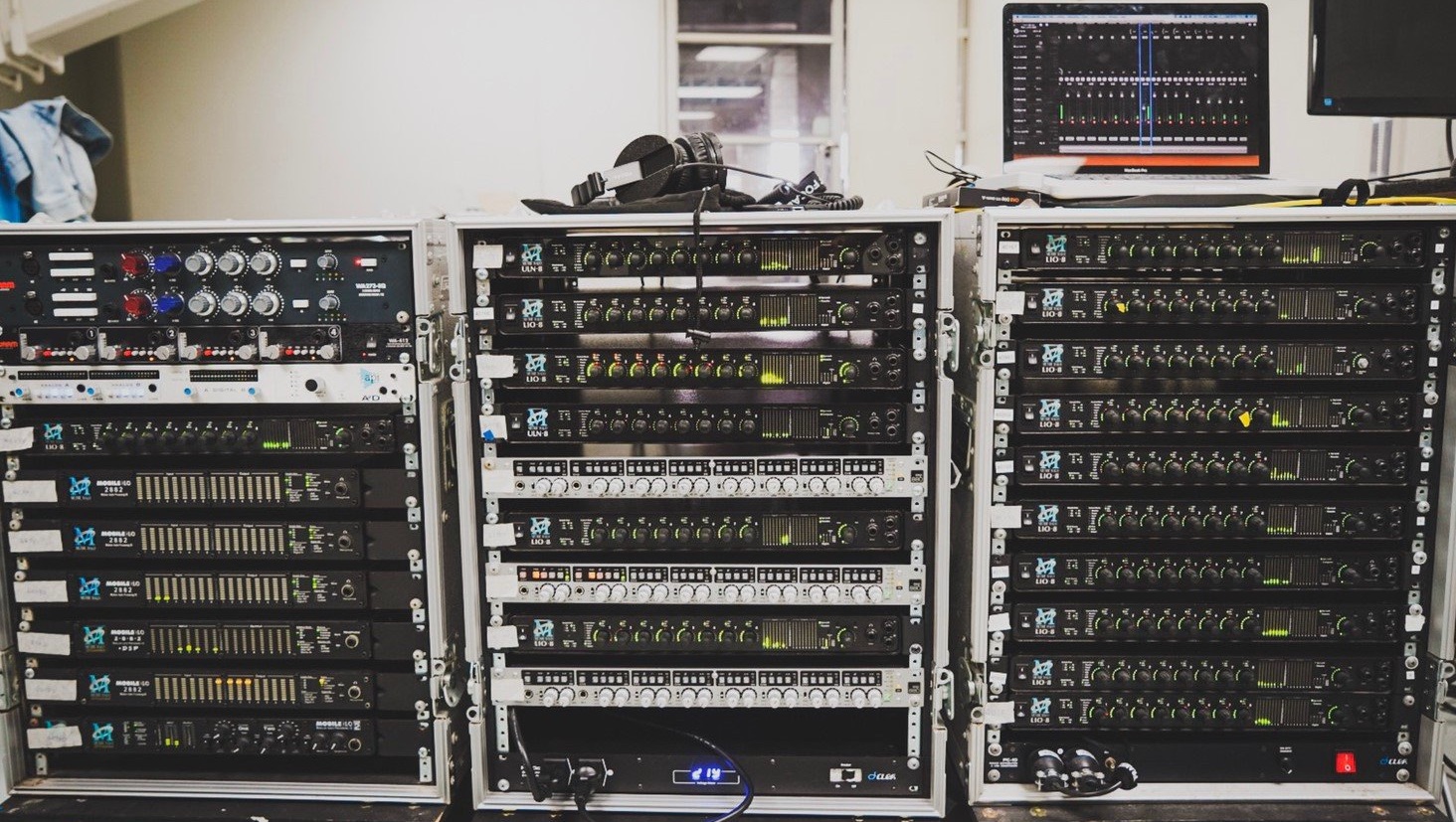
Session
Recording and playback capabilities have been a part of Metric Halo products since 1997 with the Capture Panel in our SpectraFoo Audio Analysis and Metering software package.
In 2002, elements of SpectraFoo’s Capture Panel found a new home as the multitrack MIOConsole Record Panel, included with each Mobile I/O 2882, ULN-2, and later with the second-generation ULN-8 and LIO-8 devices.
Renowned for its rock-solid reliability, sound quality and ease-of-use, the MIOConsole Record Panel remains a go-to recording tool for high-end mastering, audio preservation, live recording and technical analysis engineers today.
Every mkIV unit includes Session - the new tracking DAW that we evolved from the humble beginnings of the Record Panel.
Not limited to just recording, Session includes:
- Multitrack waveform overviews for the audio playing back
- Multitake playback without having to load the takes into a third party DAW
- Multitrack playback with instant cueing against waveforms
- Support for dropping marks on the timeline during recording and playback
- Support for Cueing to marks
- Overdubs, Segments and Edits
The same EDL (edit decision list) Engine that enables overdubs also supports audio editing functionality including segment drag, drop and copy, timeline selections, cut copy and paste, all with integrated fades.
Since Session is part of MIOConsole3d and has deep control of the hardware, overdubs are performed with dynamic monitor switching on record-enabled channels in the hardware mixer with crossfades on punch in/out, and with the ability to monitor both recorded tracks and live inputs through zero-latency DSP processing.
We have included track export functionality so that when you are ready to transition from tracking to production or mix down you can easily migrate your tracks to the DAW(s) of your choice.
The combination of zero latency monitoring with signal processing, automatic routing, pre-recording, overdubs and editing allows you to optimize your multichannel recording process. Whether you are doing long form live recordings, take-based recordings, or full-blown multipass recordings with overdubs Session will allow you to capture quickly and easily with ultimate fidelity and stability.
Session’s level-based trigger, loop-recording, and autopunch functionality makes it just as easy to record yourself by yourself as it is to record for others.
In addition to DAW-style timeline recording, Session supports the original Take-based field recording model that enables easy import of takes into other DAW systems and also enables take-based recording workflows simultaneously with the session based workflow.
Session supports BWF time stamping from SMPTE LTC and the integrated sample-accurate LTC time code reader. LTC can be input via any input, or via the dedicated SMPTE LTC input port included on every ULN-8 mkIV unit.
Session also includes extensive recording metadata in each file, including support for iXML.
The combination of pre-roll, time stamping, iXML metadata and polyphonic file recording allow you to optimize the take-based recording workflow for industry standard field recording operations.
Combined with the Mixer, Session provides a complete Production Mixing and Recording solution for for on-set recording for Film and TV.
Session Features
- Each domain has its own session
- Time-based, multi-track, multi-region session for recordings, saved as part of console file
- Each track supports unlimited Audio Segments
- Each Audio Segment has an adjustable:
- Fade-in & Fade-out
- Multiple fade types
- Adjustable Fade length
- Gain
- Mute
- Fade-in & Fade-out
- Each track supports an unlimited number of Audio Segment overlaps
- Session supports time signature and tempo to provide a musical timeline
- Session can calculate tempo from Loop, Autopunch, and Selection regions
- Session provides the user-selectable timeline rulers:
- Bars & Beats
- SMPTE Time Code
- Time
- Sample
- Session has loop points for loop Playback and Recording
- Session has in and out points for Auto punch Recording
- Session supports musical grid
- Bars down to 1/64 notes; support for triplet and dotted spacing
- Related to Time signature and Tempo
- Loop, In/Out, Playhead and segments are snapped to grid when enabled
- Session supports an unlimited number of marks
- Each mark has:
- Start Time
- Duration
- Name
- Reason Field
- Notes Field
- Marks with duration can recall loop points
- Each mark has:
- Session includes a metronome locked to Time Signature and Tempo with a dedicated strip in the mixer
- Session Playback Engine
- Plays each track to its own strip in the mixer
- Automatically routes playback to input strip tape returns
- Supports Loop playback
- Supports Count off
- Supports instant cueing to location
- Supports instant cueing to mark
- Supports delayed cueing to mark when currently playing a loop
- Multichannel files are down-mixed when added to narrower tracks
- Mono files are up-mixed when added to wider tracks
- Responds instantly to Changes, even while in loop playback.
- Cueing
- Loop-point changes
- Segment Gain, Mute, Fades postion
- Adding and removing segments
- Session supports simplified editing model including
- Auto-editing modes for drags and punches
- Split and Add (splits existing segments on overlap, adds new segment)
- Split and Remove (splits and removes existing segments on overlap, adds new segment)
- Split and Mute (splits and mutes existing segments on overlap, adds new segment)
- Add (adds new segment)
- Auto-edits support user selectable cross fade times
- Multiple Segments can be selected
- Time regions can be selected
- Segments can be:
- split, topped, and tailed at the playhead or selection
- split or trimmed to the loop points or selection
- named
- moved or copied
- snapped to the grid
- removed
- Selections can be cut or copied to the clipboard
- The clipboard can be pasted at the playhead or selection point
- Media file for Segment can be replaced
- Audio files can be revealed in the Finder from the Segment
- Auto-editing modes for drags and punches
- Import/Export
- Segments can be exported as new audio files (with trimming, gain and fades applied)
- Individual tracks can be exported as new audio files
- Individual tracks can be exported as new audio files, trimmed to loop points
- All tracks can be exported as new audio files
- All tracks can be exported as new audio files, trimmed to loop points
- The Selected area of the Session can be exported as new audio files
- Folders of existing audio files can be imported into new tracks
- Folders of takes can be imported into new tracks, with takes loaded successively on new tracks
- Audio files can be dragged directly into tracks in the Session window
- Multiple Audio files can be dragged and dropped onto successive tracks
- File management
- Session detects when media files are not found
- All playlist information is maintained
- Intelligent multi-file find tool to locate missing files
- Supports finding files that have been renamed or moved
- Found files are immediately reattached to playlist
- Session detects when media files are not found
- Recording
- Record-enabled tracks record to record folders (with mirroring)
- User specified file and take folder naming rules
- Take number management
- Tracks are recorded to files with natural width
- Mono tracks record to mono files
- Stereo tracks record to stereo files
- 5.1 tracks record to 5.1 files
- etc.
- Session always records pre-insert, and plays back through inserts
- Session can record onto bus tracks
- Bus tracks do not play back
- If you want to play back a bus track, you need to move the file to an input track
- Mixer now supports “tape” returns and is transport-state aware
- When transport is stopped, mixer monitors inputs
- When transport is in Play
- For tracks with Segments
- Not record enabled
- Mixer monitors tape returns
- Record Enabled
- Mixer monitors mix of input + tape returns
- Not record enabled
- For tracks with Segments
- When transport is in Record
- For tracks with Segments
- Not record enabled
- Mixer monitors tape returns
- Record Enabled
- Mixer monitors input
- Not record enabled
- For tracks with Segments
- Monitoring follows transport state dynamically, providing cross-faded punch in support
- Recorded files continue to support pre-roll/pre-record
- Segments are added starting at trigger time, and ending at end of record
- Segments are added using the specified Punch Mode (described above) and cross fade Time
- Audio file may extend before and after segment; additional material can be revealed by dragging segment trim points
- Segments take into account latencies when recording and are aligned with the playback timeline
- Recording supports multiple modes:
- Take: Recording starts at current playhead time, but does not start playback. Playhead is advanced at each new take
- Count in: None - Playback and Recording start at the current playhead position
- Count in: 1-4 Bars - Playback starts specified number of bars before the current playhead position, and recording punches in when the playhead reaches its original position.
- Count in mode uses loop start or punch-in point as the starting point if one off those modes is active
- Loop Recording Modes
- Loop Mode: Recording starts when triggered, and punches out at end of loop and is rearmed for next loop pass; this means all new material is recorded within the boundaries of the loop
- Loop to Linear Mode: Playback follows the specified loop, and recording starts at the playhead position when triggered, but continues recording linearly while playback loops. This is great for recording non-looping material against a looped basic track.
- Record-enabled tracks record to record folders (with mirroring)
- SMPTE LTC Timecode reader
- Timestamps BWF files from LTC or TOD
- Comprehensive field recording metadata in BEXT and iXML chunks
- Support for overall polyphonic take files with all channels

Stand-alone Operation
Flexible signal routing and sophisticated patch and preset management systems as well as a comprehensive set of front panel controls are also featured in the ULN-8 mkIV. The mkIV’s front-panel controls allow the unit to function equally as well as a stand-alone Mic Pre/Converter system. In standalone mode, the mkIV operates with the converters directly routed to and from the AES I/O, and the analog sends allow purely analog operation of the preamps.
As a standalone converter, the ULN-8 mkIV provides a 24bit/192kHz eight channel front-end with 8 world-class boutique-quality ULN-R mic pres for any recording system. It also functions seamlessly as an analog monitor controller, making it ideal as a digital headphone amp and studio monitor controller.
Boot States / Snapshots
ULN-8 mkIV has support for saving and recalling hardware Boot States and Snapshots.
Boot States are automatically applied by the hardware when it is booting up. Snapshots may be recalled manually from the front panel.
When you save a snapshot to the hardware, everything required to restore the current running state of the hardware is gathered up and stored on the hardware. This includes:
- Routing
- Mixer Gains
- Pans
- Mutes
- DSP plugins
- DSP settings
- Interbox Routing
- Clock source
- Sample Rate
- Computer Routing (including SCP)
On boot/recall all the settings listed above are set on the hardware (including all the connected units in an MHLink domain. The ULN-8 mkIV also provides extensive front panel controls that allow you to change a wide variety of hardware parameters after the recall of the boot state. This combination of features allows you to configure your hardware for Standalone operation - for example you can configure your ULN-8 mkIV as a standalone Mic Pre, A/D/A converter, Format Converter or Monitor controller (or any combination of these functions).
Features in Detail
- 8 Channels of stunning 192k A/D converters
- Utterly transparent, spacious, detailed A/D conversion
- Digitally Controlled Analog Input Trim
- 8 Channels of stunning 192k D/A converters
- Warm, engaging, expansive and immersive D/A conversion
- DC-coupled for ultra-low phase distortion
- Digitally Controlled Analog Output Trim
- All D/A outputs Relay Shunt muted for direct connection to amps/monitors
- 2 Channels of stunning 192k D/A converters with integrated headphone amp
- Featuring the same high-quality DC-coupled conversion as the main DACs
- Dedicated, digitally-controlled high-power headphone amplifier
- 8 Channels of Exceptional Remote Controllable Ultra-Low-Noise Clickless Mic Preamps
- Metric Halo custom High-Headroom Digitally Controlled analog preamps
- Metric Halo Zero-Cross switching technology for clickless operation
- Discrete gain and trim stages for ultra-high headroom operation (supports +20 dBu input)
- Analog Send/Return architecture for analog access to preamps (pre A/D)
- Analog sends from preamps (multed pre-A/D)
- Analog only preamp operation capable (with fine trim)
- Integrated analog router to allow insert of external analog processing pre-A/D
- 2 Channels of Exceptional DI inputs suitable for instrument or turntable inputs
- Ultra-High-Z for no instrument loading
- Balanced or unbalanced operation
- Jumper configurable pre-trim gain
- Integrated Surround Monitor Controller
- Provides switching between any set of user specified sources (Host, USB, AES, Analog, ADAT, MADI or Mix)
- Analog gain control for monitor output from Front Panel or computer
- Mute, Dim, and Mono Fold-down
- Non-destructive routable PFL/AFL Solo monitoring
- Talkback and Listenback to Cue points
- Independent channel level and delay calibration for each output path
- Flexible B-Chain processing integrated in Output paths
- Supports input and monitor paths from Mono to Atmos 7.1.4
- 8 Channels of 192k capable AES Inputs and Outputs
- Available as computer I/O or direct routed I/O for converters
- Support full channel count at all sample rates
- Professional interfacing
- Open EdgeBus Card Slot available for Expansion via any one of:
- AES/SPDIF EdgeCard (4 in/4 out)
- DB-25 AES EdgeCard (8 in/8 out)
- SPDIF + MIDI EdgeCard (2 in/2 out + MIDI I/O)
- SPDIF + 2x ADAT EdgeCard (18 in/18 out)
- 2x SPDIF + 2x ADAT EdgeCard (20 in/20 out)
- 4x ADAT EdgeCard (32 in/32 out)
- 2x MADI Optical EdgeCard (128 in/128 out)
- 1x MADI Optical + 1x MADI Copper EdgeCard (128 in/128 out)
- 4x MADI Copper EdgeCard (256 in/256 out)
- Comprehensive Front Panel Controls
- Full support for standalone converter and preamp operation
- Sample Rate selection
- Clock source selection
- Input source selection
- Phantom power control
- Tactile Control of Input and Output gains
- Gain level indication with MH Digital Dual Vernier Technology
- Numeric gain level indication while changing gains
- Tactile Control Headphone level
- Tactile Control Monitor Controller gain (mono - 7.1.4)
- Preset recall
- Multichannel gain linking control
- Monitor Controller control surface
- User-controllable brightness
- User-controllable knob sensitivity
- Full support for standalone converter and preamp operation
- Comprehensive, High Resolution 15 Segment Precision Front Panel Metering
- Real, functional metering for analog inputs and outputs
- Unique ‘Meter on knob’ functionality
- Multi-color signal level/presence metering for AES inputs and outputs
- Comprehensive Clocking (Internal, Word Clock, AES, MHLink, EdgeBus)
- Dedicated internal clock sources for all rates
- Dedicated MIDI I/O
- MIDI Input and Output on standard DIN connectors
- MIDI transported to computer
- Dedicated SMPTE LTC I/O for Timecode without sacrificing any audio channels
- Properly conditioned and band-limited SMPTE I/O on TRS balanced connections
- Available to any CoreAudio application as audio streams
- Directly routable to Session SMPTE decoder
- Rock-solid, time-tested sixth-generation software and drivers
- Integrated Mixing and Deep Instantiable DSP Processing (Includes Full +DSP License)
- Fully configurable multibus mixer with surround support (up to 7.1)
- Full Send/Return architecture
- I/O Inserts
- Pre and Post Insert routing
- Auto-channel input monitoring with Session
- Latency compensated Aux and Group Buses
- On-strip Aux Sends
- Aux on Main Surface Mode
- Optional non-destructive PFL/AFL solo modes
- Optional per-strip Hard Mutes
- Link Groups
- Mute Groups
- DCAs
- Ultra-low latency, on-the-metal monitoring
- Insert model for inserting zero-latency plugins
- Insertable +DSP plugin graphs for configurable processing
- Insertable graph macros for complex, pre-configured processing
- Includes over 100 world-renowned Metric Halo processing plugins, including:
- ChannelStrip
- DirtyDelay
- Multiband Dynamics
- Multiband Expander
- TransientControl
- MHCharacter
- HaloVerb
- Precision De-esser
- Thump
- SuperGate
- SonicEQ
- MBEQ
- MBParallel 1, 2 & 3+4
- MBGoodMath
- MIOStrip
- Dynamics (Compressor and Limiter)
- EQ (6 band and 12 band)
- Signal Processing primitives
- Crossovers
- and much more…
- Per-channel and Per-bus Insertable Character™
- Fully configurable multibus mixer with surround support (up to 7.1)
- MHLink Interfacing between boxes with automatic box-to-box:
- Routing
- Clocking
- Interface Aggregation
- 1 Sample Routing Latency across entire domain
- Ethernet Interfacing to computer with MHLink Audio
- Supports macOS v.10.9.x and newer
- 128x128 channel interface @ 192k
- Driverless USB Class Audio Interfacing
- macOS v.10.6.8 and newer
- iOS (iPhone)
- iOS (iPad)
- Win 10 and newer
- Android
- Linux
- Other USB UAC2 hosts
- Bidirectional Control Surface Support
- Integrated Front Panel Tactile Controls
- Mackie Control Protocol Control Surfaces
- Eucon Control Surfaces
- Avid Control via iPad/iPhone/Android
- IR Remote
- Session: Integrated Multichannel Tracking DAW
- Multichannel, multi-box DAW-style high-performance recorder
- Multitrack DAW-style playback with cueing
- Overdub and editing support
- Integrated segment fades and multisegment overlap
- Exceptional Stability and Sound Quality
- Realtime waveform display
- Extensive File Format support (BWF, WAVE, AIFF)
- BWF time-stamping from TOD or LTC (any input channel or dedicated SMPTE input)
- Support for extensive BWF metadata
- Support for extensive iXML metadata
- Support for limiting record file size and seamless file breaking
- Seamless manual file breaking (with time-stamping)
- Support for mirrored recording (recording to multiple drives at once)
- Pre-roll/Pre-record
- Dreamcatcher™ Level Based trigger
- Timecode based trigger
- Monophonic and polyphonic recording (determined by source strip width)
- Support for overall poly-file recording for film/field recording workflows
- DC-Powerable
- Supports battery power with no inverter
- External power via XLR-4 Locking Connector
- High quality, custom designed formed powder-coated aluminum case
- Strong
- Light weight
- Scratch and fingerprint resistant
- Smooth contours for snag-free transportation in a gig-bag
- Rack-mountable with included rack-ear kit
- Exceptional Power Performance (only 20 Watts nominal / 25 Watts max)
- Silent, fan-less design
- Low mass (6 lbs / 2.7 kg)
- Extremely Compact (everything in 1 RU)
- Includes MHLink and USB-A to USB-C Cable kit
- Includes External Power Supply and IEC cable
- Future-Proof, Expandable, and software-enhanceable
System Requirements
Computer:
- Any Mac that supports macOS 10.9.x or newer with a 64-bit Intel or Apple Silicon Processor
- One of:
- USB port
- Built-in Gigabit Ethernet Port
- Thunderbolt Gigabit Ethernet Adapter
- Thunderbolt Dock with Gigabit Ethernet Adapter
- USB3 to Gigabit Ethernet Adapter
- PCIe Gigabit Ethernet Card
OS:
- macOS 10.9.x or newer required
Software:
- All CoreAudio compliant software is compatible with ULN-8 mkIV, including:
- Cubase
- Digital Performer
- GarageBand
- iTunes
- Abelton Live
- Logic
- Studio One
- Bitwig
- Nuendo
- Resolve
- MixBus 32c
- soundBlade
- Pro Tools
- Final Cut Pro
- and hundreds more…
What’s Included in the Package
Each ULN-8 mkIV includes the following items:- One ULN-8 mkIV unit
- One IEC Power Cord appropriate for your area
- One 19-volt 60-watt world-ready external power supply
- One 2’ and One 10’ CAT5e Ethernet Cable
- One USB-A to USB-C Cable
- Two Rack Ears with fasteners
- Rubber feet
- Configuration jumpers
- Warranty/Registration Card
Differences between ULN-8 mk IV and ULN-8 3d
ULN-8 mk IV features:
- A new analog and converter design with even more detail, body and soul
- A huge reduction in converter round trip latency (RTL)
- Next-gen design optimized for low-latency unity-gain analog loops
- A relay-based output mute system for click & pop-free power cycles
- 35% reduction in power consumption - it runs cooler and is better for the environment
| ULN-8 mk IV | ULN-8 3d | |
| Digital Design | Gen 3 | Gen 3 |
| Analog Design | Gen 4 | Gen 3 |
| Converter Design | Gen 4 | Gen 2 |
| Power Consumption | 20.7 Watts | 32 Watts |
| Converter RTL | 18 samples | 116 samples |
| Unity-gain analog loop | Yes | No |
| Relay Mute | Yes | No |


